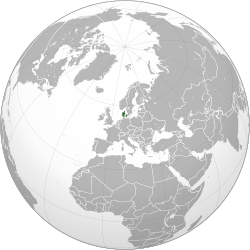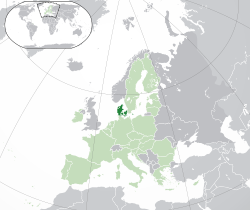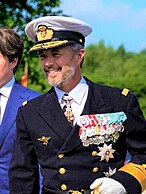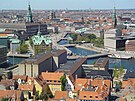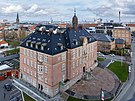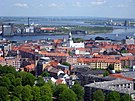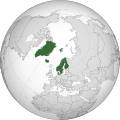Denmark
Denmark Danmark(Danish) | |
|---|---|
| Anthem:Der er et yndigt land(Danish) (English:"There is a lovely country") | |
| National and royal anthem:Kong Christian stod ved højen mast(Danish)[N 1] (English:"King Christian stood by the lofty mast") | |
Location of metropolitan Denmark (dark green) – inEurope(light green & dark grey) | |
| Sovereign state | Kingdom of Denmark |
| Consolidation | c.8th century[2] |
| Constitutional Act | 5 June 1849 |
| Capital and largest city | Copenhagen 55°43′N12°34′E/ 55.717°N 12.567°E |
| Official languages | Danish |
| German[N 2] | |
| Ethnic groups (2020) | |
| Demonym(s) | |
| Government | Unitary parliamentaryconstitutional monarchy |
| Frederik X | |
| Mette Frederiksen | |
| Legislature | Folketing |
| Area | |
• Total | 43,094[5]km2(16,639 sq mi) (130th) |
• Water (%) | 1.74[6] |
| Highest elevation (Møllehøj) | 170.86 m (560.56 ft) |
| Population | |
• February 2023 estimate | |
• Density | 138.29/km2(358.2/sq mi) (93rd) |
| GDP(PPP) | 2024 estimate |
• Total | |
• Per capita | |
| GDP(nominal) | 2024 estimate |
• Total | |
• Per capita | |
| Gini(2022) | low |
| HDI(2022) | very high·5th |
| Currency | Danish krone[N 6] |
| Time zone | UTC+01:00(CET) |
• Summer (DST) | UTC+02:00(CEST) |
| Calling code | +45 |
| Internet TLD | .dk[N 7] |
| Website | denmark |
Denmark(Danish:Danmark,pronounced[ˈtænmɑk]) is aNordiccountry in the south-central portion ofNorthern Europewith a population of nearly 6 million;[11]767,000 live inCopenhagen(1.9 million in the wider area).[12]It is the metropolitan part of and the most populous constituent of theKingdom of Denmark,[N 8]a constitutionallyunitary statethat includes theautonomous territoriesof theFaroe IslandsandGreenlandin theNorth Atlantic Ocean.[13]Metropolitan Denmark[N 9]is the southernmost of theScandinaviancountries, lying south-west and south ofSweden,south ofNorway,[N 10]and north ofGermany,with which it shares a short border.
As of 2013, theKingdom of Denmark,including theFaroe IslandsandGreenland,had a total of 1,419 islands greater than 100 square metres (1,100 sq ft) in area; 443 of these have been named and 78 are inhabited.[14]Spanning a total area of 42,943 km2(16,580 sq mi),[15]metropolitan Denmark consists of the northern part of theJutlandpeninsulaand anarchipelagoof406 islands.[16]Of these, the most populated island isZealand,on which the capital and largest city,Copenhagen,is situated, followed byFunen,theNorth Jutlandic Island,andAmager.[17]Denmark has flat,arable land,sandy coasts, low elevations, and atemperate climate.Denmark exerciseshegemonicinfluence in theDanish Realm,devolvingpowers to handle internal affairs.Home rulewas established in the Faroe Islands in 1948 and inGreenlandin 1979; the latter obtainedfurther autonomyin 2009.[18]
Theunified Kingdom of Denmarkemerged in the 8th century AD as a proficient maritime power amid the struggle forcontrol of the Baltic Sea.[2]In 1397, it joined Norway and Sweden to form theKalmar Union,which persisted untilthe latter's secessionin 1523. The remaining Kingdom ofDenmark–Norwayendured aseries of warsin the 17th century that resulted in furtherterritorial cessions.A surge ofnationalist movementsin the 19th century were defeated in theFirst Schleswig Warof 1848. The adoption of theConstitution of Denmarkon 5 June 1849 ended theabsolute monarchyand introduced the current parliamentary system. An industrialised exporter ofagriculturalproduce in the second half of the 19th century, Denmark introducedsocial and labour-market reformsin the early 20th century, which formed the basis for the presentwelfare statemodeland advancedmixed economy.Denmark remained neutralduringWorld War I;Danish neutrality was violated inWorld War IIby a rapidGerman invasionin April 1940. During occupation, aresistance movementemerged in 1943, while Iceland declared independence in 1944; Denmark wasliberatedafter the end of the war in May 1945. In 1973, Denmark, together withGreenlandbut not theFaroe Islands,became a member of what is now theEuropean Union,but negotiatedcertain opt-outs,such as retaining its own currency, thekrone.
Denmark is adeveloped countrywith a highstandard of living,and was the first country to legally recognisesame-sex partnerships.It is a founding member ofNATO,theNordic Council,theOECD,theOSCE,theUnited Nationswhere it is a member of theSecurity Council,and is part of theSchengen Area.Denmark maintains close political, cultural, and linguistic ties with its Scandinavian neighbours. The Danish political system is used inpolitical scienceas a reference point for near-perfect governance and the term "getting to Denmark" is used to describe how other countries can improve their governments.[19][20]
Etymology
The etymology of the name "Denmark", the relationship between "Danes" and "Denmark", and the emergence of Denmark as a unified kingdom are topics of continuous scholarly debate.[21][22]This is centred primarily on the morpheme"Dan"and whether it refers to theDanior a historical personDanand the exact meaning of the -"mark"ending.
Most etymological dictionaries and handbooks derive "Dan" from a word meaning "flat land",[23]related to GermanTenne"threshing floor", Englishden"cave".[23]The elementmarkis believed to meanwoodlandorborderland(seemarches), with probable references to the border forests in southSchleswig.[24]
The first recorded use of the wordDanmarkwithin Denmark itself is found on the twoJelling stones,which arerunestonesbelieved to have been erected byGorm the Old(c. 955) andHarald Bluetooth(c. 965). The larger of the two stones is popularly cited as the "baptismal certificate" (dåbsattest) of Denmark,[25]though both use the word "Denmark", in theaccusativeᛏᛅᚾᛘᛅᚢᚱᚴtanmaurk([danmɒrk]) on the large stone, and thegenitiveᛏᛅᚾᛘᛅᚱᚴᛅᚱ"tanmarkar" (pronounced[danmarkaɽ]) on the small stone, while thedativeformtąnmarku(pronounced[danmarkʊ]) is found on the contemporaneous Skivum stone. The inhabitants of Denmark are there calledtani([danɪ]), or "Danes", in the accusative.
History
Prehistory
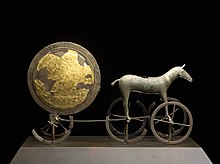
The earliestarchaeological finds in Denmarkdate back to theEem interglacial periodfrom 130,000 to 110,000BC.[26]Denmark has been inhabited since around 12,500 BC and agriculture has been evident since 3900 BC.[27]TheNordic Bronze Age(1800–600 BC) in Denmark was marked byburial mounds,which left an abundance of findings includinglursand theSun Chariot.
During thePre-Roman Iron Age(500 BC – AD 1), native groups began migrating south, and the first tribalDanescame to the country between the Pre-Roman and theGermanic Iron Age,[28]in theRoman Iron Age(AD 1–400).[27]TheRoman provincesmaintainedtrade routesand relations with native tribes in Denmark, andRoman coinshave been found in Denmark. Evidence of strongCelticcultural influence dates from this period in Denmark and much of North-West Europe and is among other things reflected in the finding of theGundestrup cauldron.
The tribal Danes came from the eastDanish islands(Zealand) andScaniaand spoke an early form ofNorth Germanic.Historians believe that before their arrival, most ofJutlandand the nearest islands were settled by tribalJutes.Many Jutes migrated toGreat Britain,according to legend some as mercenaries ofBrythonicKingVortigern,and formed the south-eastern territories ofKent,theIsle of Wightand other areas, where they settled. They were later absorbed orethnically cleansedby the invadingAnglesandSaxons,who formed theAnglo-Saxons.The remainingJutishpopulation in Jutland assimilated in with the settlingDanes.
A short note about theDaniinGeticaby the historianJordanesis believed to be an early mention of the Danes, one of theethnic groupsfrom whom modernDanesare descended.[29][30]TheDanevirkedefence structures were built in phases from the 3rd century forward and the sheer size of the construction efforts in AD 737 are attributed to the emergence of a Danish king.[31]Anew runic Alpha betwas first used around the same time andRibe,the oldest town of Denmark, was founded about AD 700.
Viking and Middle Ages
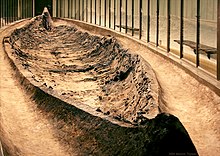
From the 8th to the 10th century the widerScandinavianregion was the source ofVikings.They colonised, raided, and traded in all parts of Europe. The Danish Vikings were most active in the eastern and southernBritish IslesandWestern Europe.They settled in parts ofEngland(known as theDanelaw) under KingSweyn Forkbeardin 1013, and inFrancewhere Danes and Norwegians were allowed to settle in what would becomeNormandyin exchange of allegiance toRobert I of FrancewithRolloas first ruler. SomeAnglo-Saxonpenceof this period have been found in Denmark.[32]
Denmark was largely consolidated by the late 8th century and its rulers are consistently referred to inFrankishsources as kings (reges). Under the reign ofGudfredin 804 the Danish kingdom may have included all thelandsof Jutland,Scaniaand the Danish islands, excluding Bornholm.[33]
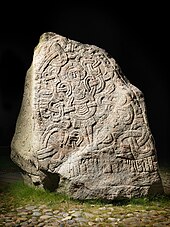
The extant Danish monarchy traces its roots back toGorm the Old,who established his reign in the early 10th century.[2]As attested by theJelling stones,the Danes wereChristianisedaround 965 byHarald Bluetooth,the son ofGormandThyra.It is believed that Denmark became Christian for political reasons so as not to get invaded by theHoly Roman Empire.A rising Christian power in Europe, the Holy Roman Empire was an important trading partner for the Danes. As a deterrent against this threat, Harald built sixfortressesaround Denmark calledTrelleborgand built a furtherDanevirke.In the early 11th century,Canute the Greatwon and united Denmark, England, andNorwayfor almost 30 years with a Scandinavian army.[32]
Throughout theHighandLate Middle Ages,Denmark also includedSkåneland(the areas of Scania,Halland,andBlekingein present-day south Sweden) and Danish kings ruledDanish Estonia,as well as theduchiesofSchleswigandHolstein.Most of the latter two now form the state ofSchleswig-Holsteinin northern Germany.
In 1397, Denmark entered into apersonal unionknown as theKalmar UnionwithNorwayandSweden,united under QueenMargaret I.[34]The three countries were to be treated as equals in the union. However, even from the start, Margaret may not have been so idealistic—treating Denmark as the clear "senior" partner of the union.[35]Thus, much of the next 125 years ofScandinavian historyrevolves around this union, with Sweden breaking off and being re-conquered repeatedly. The issue was for practical purposes resolved on 17 June 1523, asSwedish KingGustav Vasaconquered the city ofStockholm.TheProtestant Reformationspread to Scandinavia in the 1530s, and following theCount's Feudcivil war,Denmark convertedtoLutheranismin 1536. Later that year, Denmark entered into a union with Norway.
Early modern history (1536–1849)
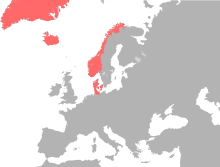
After Sweden permanentlybroke awayfrom the personal union, Denmark tried on several occasions to reassert control over its neighbour. KingChristian IVattacked Sweden in the 1611–1613Kalmar Warbut failed to accomplish his main objective of forcing it to return to the union. The war led to no territorial changes, but Sweden was forced to pay awar indemnityof 1 million silverriksdalerto Denmark, an amount known as theÄlvsborg ransom.[36]King Christian used this money to found several towns and fortresses, most notablyGlückstadt(founded as a rival toHamburg) andChristiania.Inspired by theDutch East India Company,he founded a similarDanish companyand planned to claimCeylonas a colony, but the company only managed to acquireTranquebaron India'sCoromandel Coast.Denmark's large colonial aspirations included a few keytrading postsinAfricaandIndia.While Denmark's trading posts in India were of little note, it played an important role in the highly lucrativeAtlantic slave trade,through its trading outposts inFort ChristiansborginOsu,Ghanathrough which 1.5 million slaves were traded.[37]While the Danish colonial empire was sustained by trade with other major powers, andplantations– ultimately a lack of resources led to its stagnation.[38]
In theThirty Years' War,Christian tried to become the leader of theLutheranstates in Germany but suffered a crushing defeat at theBattle of Lutter.[39]The result was that the Catholic army underAlbrecht von Wallensteinwas able to invade, occupy, and pillage Jutland, forcing Denmarkto withdraw from the war.[40]Denmark managed to avoid territorial concessions, but KingGustavus Adolphus' intervention in Germany was seen as a sign that the military power of Sweden was on the rise while Denmark's influence in the region was declining. Swedish armiesinvaded Jutlandin 1643 and claimed Scania in 1644. In the 1645Treaty of Brømsebro,Denmark surrendered Halland,Gotland,the last parts of Danish Estonia, and several provinces in Norway.
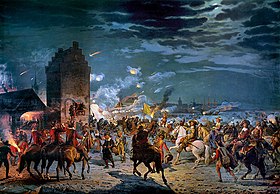
Seeing an opportunity to tear up the Treaty of Brømsebro, KingFrederick III of Denmark,in 1657, declared war on Sweden, the latter being deeply involved in theSecond Northern War(1655–1660), and marched onBremen-Verden.This led to a massive Danish defeat as the armies of KingCharles X Gustavof Sweden conqueredJutlandand, following theSwedish March acrossthe frozenDanish straits,occupiedFunenand much ofZealandbefore signing thePeace of Roskildein February 1658, which gave Sweden control of Scania,Blekinge,Bohuslän,Trøndelag,and the island ofBornholm.Charles X Gustav quickly regretted not having ruined Denmark and in August 1658, he launched asecond attack on Denmark,conquered most of the Danish islands, and began a two-year-long siege ofCopenhagen.King Frederick III actively led the defence of the city, rallying its citizens to take up arms, andrepelled the Swedish attacks.[41][42]The siege ended following the death of Charles X Gustav in 1660.[43]In the ensuingpeace settlement,Denmark managed to maintain its independence and regain control of Trøndelag and Bornholm.[44]Attaining great popularity following the war, Frederick III used this todisband the elective monarchyin favour ofabsolute monarchy,which lasted until 1848 in Denmark.[45]
Denmark tried but failed to regain control of Scania in theScanian War(1675–1679). After theGreat Northern War(1700–21), Denmark managed to regain control of the parts ofSchleswigandHolsteinruled by the house ofHolstein-Gottorpin the 1720Treaty of Frederiksborgand the 1773Treaty of Tsarskoye Selo,respectively. Denmark prospered greatly in the last decades of the 18th century due to itsneutral statusallowing it to trade with both sides in the many contemporary wars. In theNapoleonic Wars,Denmark traded with bothFranceand theUnited Kingdomand joined theLeague of Armed NeutralitywithRussia,Sweden, andPrussia.[46]The British considered this a hostile act and attacked Copenhagen in1801and1807,in one case carrying off theDanish fleet,in the other, burning large parts of the Danish capital. This led to the so-called Danish-BritishGunboat War.British control of the waterways between Denmark and Norway proved disastrous to the union's economy and in 1813 Denmark–Norway wentbankrupt.
The union was dissolved by theTreaty of Kielin 1814; the Danish monarchy "irrevocably and forever" renounced claims to the Kingdom of Norway in favour of the Swedish king.[47]Denmark kept the possessions ofIceland(which retained the Danish monarchy until 1944), theFaroe IslandsandGreenland,all of which had been governed by Norway for centuries.[48]Apart from the Nordic colonies, Denmark continued to rule overDanish Indiafrom 1620 to 1869, theDanish Gold Coast(Ghana) from 1658 to 1850, and theDanish West Indiesfrom 1671 to 1917.
Constitutional monarchy (1849–present)

A nascent Danish liberal and national movement gained momentum in the 1830s; after the EuropeanRevolutions of 1848,Denmark peacefully became aconstitutional monarchyon 5 June 1849. A new constitution established atwo-chamber parliament.Denmark faced war against bothPrussiaand theAustrian Empirein what became known as theSecond Schleswig War,lasting from February to October 1864. Denmark was defeated and obliged tocedeSchleswig and HolsteintoPrussia.This loss came as the latest in the long series of defeats andterritoriallosses that had begun in the 17th century. After these events, Denmark pursued a policy of neutrality in Europe.
Industrialisationcame to Denmark in the second half of the 19th century.[49]Thenation's first railwayswere constructed in the 1850s, and improved communications and overseas trade allowed industry to develop in spite of Denmark's lack of natural resources.Trade unionsdeveloped, starting in the 1870s. There was a considerable migration of people from the countryside to the cities, and Danish agriculture became centred on the export of dairy and meat products.
Denmarkmaintained its neutral stanceduringWorld War I.After the defeat of Germany, theVersailles powersoffered to return the region of Schleswig-Holstein to Denmark. Fearing Germanirredentism,Denmark refused to consider the return of the area without aplebiscite;the twoSchleswig Plebiscitestook place on 10 February and 14 March 1920, respectively. On 10 July 1920, Northern Schleswig was recovered by Denmark, thereby adding some 163,600 inhabitants and 3,984 square kilometres (1,538 sq mi). The country's first social democratic government took office in 1924.[50]
In 1939 Denmark signed a 10-year non-aggression pact withNazi GermanybutGermany invaded Denmarkon 9 April 1940 and the Danish government quickly surrendered.World War II in Denmarkwas characterised by economic co-operation with Germany until 1943, when the Danish government refused further co-operation andits navyscuttled most of its shipsand sent many of its officers to Sweden, which was neutral. TheDanish resistanceperformed arescue operationthat managed to evacuate several thousandJewsand their families to safety in Sweden before the Germans could send them to death camps. Some Danes supportedNazismby joining theDanish Nazi Partyor volunteering to fight with Germany as part of theFrikorps Danmark.[51]Iceland severed ties with Denmark andbecame an independent republicin 1944;Germany surrenderedin May 1945. In 1948, the Faroe Islands gainedhome rule.In 1949, Denmark became a founding member ofNATO.
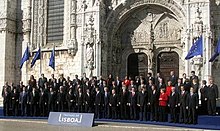
Denmark was a founding member ofEuropean Free Trade Association(EFTA). During the 1960s, the EFTA countries were often referred to as theOuter Seven,as opposed to theInner Sixof what was then theEuropean Economic Community(EEC).[52]In 1973, along with Britain and Ireland, Denmark joined the European Economic Community (now theEuropean Union) after apublic referendum.TheMaastricht Treaty,which involved further European integration,was rejectedby the Danish people in 1992; it was only accepted after asecond referendumin 1993, which provided forfour opt-outsfrom policies. The Danes rejected the euro as the national currency ina referendum in 2000.Greenland gained home rule in 1979 and was awardedself-determinationin 2009. Neither theFaroe IslandsnorGreenlandare members of the European Union, the Faroese having declined membership of the EEC in 1973 and Greenland in 1986, in both cases because of fisheries policies.
Constitutional change in 1953 led to asingle-chamberparliament elected by proportional representation, female accession to the Danish throne, and Greenland becoming an integral part of Denmark. Thecentre-leftSocial Democratsled a string of coalition governments for most of the second half of the 20th century, introducing theNordic welfare model.TheLiberal Partyand theConservative People's Partyhave also ledcentre-rightgovernments.
Geography
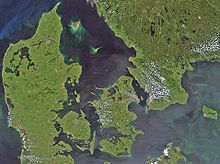
Located inNorthern Europe,Denmark[N 9]consists of the northern part of theJutlandpeninsula and anarchipelagoof406 islands.[16]Of these, the largest island isZealand,on which the capitalCopenhagenis situated, followed by theNorth Jutlandic Island,Funen,andLolland.[54]The island ofBornholmis located east of the rest of the country, in theBaltic Sea.Many of the larger islands are connected by bridges; abridge-tunnelacross theØresundconnects Zealand with Sweden; theGreat Belt Fixed Linkconnects Funen with Zealand; and theLittle Belt Bridgeconnects Jutland with Funen.Ferriesorsmall aircraftconnect to the smaller islands. The fourcities with populations over 100,000are the capitalCopenhagenon Zealand;AarhusandAalborgin Jutland; andOdenseon Funen.
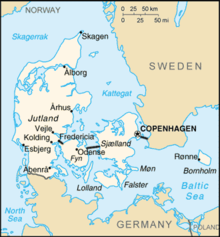
The metropolitan part occupies a total area of 42,943.9square kilometres(16,581 sq mi).[15]The area of inland water is 43 km2(17 sq mi).[55]The size of the land area cannot be stated exactly since the ocean constantly erodes and adds material to the coastline, and because of humanland reclamationprojects (to counter erosion).Post-glacial reboundraises the land by a bit less than 1 cm (0.4 in) per year in the north and east, extending the coast. A circle enclosing the same area as Denmark would be 234 kilometres (145 miles) indiameterwith acircumferenceof 736 km (457 mi) (land area only: 232.33 km (144.36 mi) and 730 km (454 mi) respectively). It shares a border of 68 kilometres (42 mi) withGermanyto the south and is otherwise surrounded by 8,750 km (5,437 mi) of tidalshoreline(including smallbaysandinlets).[56]No location in Denmark is farther from the coast than 52 km (32 mi). On the south-west coast of Jutland, the tide is between 1 and 2 m (3.28 and 6.56 ft), and the tideline moves outward and inward on a 10 km (6.2 mi) stretch.[57]Denmark'sterritorial waterstotal 105,000 square kilometres (40,541 square miles).
Denmark's northernmost point isSkagenpoint (the north beach of the Skaw) at 57° 45' 7 "northern latitude; the southernmost isGedserpoint (the southern tip ofFalster) at 54° 33' 35 "northern latitude; the westernmost point isBlåvandshukat 8° 4' 22 "eastern longitude; and the easternmost point isØsterskærat 15° 11' 55 "eastern longitude. This is in the smallErtholmenearchipelago 18 kilometres (11 mi) north-east of Bornholm. The distance from east to west is 452 kilometres (281 mi), from north to south 368 kilometres (229 mi).
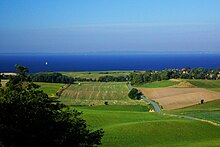
The metropolitan part is flat with little elevation, having an average heightabove sea levelof 31 metres (102 ft). The highest natural point isMøllehøj,at 170.86 metres (560.56 ft).[58]Although this is by far the lowest high point in the Nordic countries and also less than half of the highest point inSouthern Sweden,Denmark's general elevation in its interior is generally at a safe level fromrising sea levels.A sizeable portion of Denmark'sterrainconsists of rollingplainswhilst the coastline is sandy, with largedunesin northern Jutland. Although once extensively forested, today Denmark largely consists ofarable land.It is drained by adozen or so rivers,and the most significant include theGudenå,Odense,Skjern,SusåandVidå—a river that flows along its southern border with Germany. The country has 1008 lakes, 16 have an area of more than 500 hectares (1,200 acres). LakeArresø,located northwest of Copenhagen, is the largest lake.[55]
The Kingdom of Denmark includes two overseas territories, both well to the west of Denmark: Greenland, theworld's largest island,and the Faroe Islands in the North Atlantic Ocean. These territories are self-governing under their own parliaments (theLøgtingandInatsisartut) and form, together with continental Denmark, part of theDanish Realm,a country.
Climate
Denmark has atemperateclimate, characterised by cool to cold winters, with mean temperatures in January of 1.5 °C (34.7 °F), and mild summers, with a mean temperature in August of 17.2 °C (63.0 °F).[59]The most extreme temperatures recorded in Denmark, since 1874 when recordings began, was 36.4 °C (97.5 °F) in 1975 and −31.2 °C (−24.2 °F) in 1982.[60]Denmark has an average of 179 days per year with precipitation, on average receiving a total of 765 millimetres (30 in) per year; autumn is the wettest season and spring the driest.[59]The position between a continent and an ocean means that the weather is often unstable.[61]
Because of Denmark's northern location, there are large seasonal variations in daylight: short days during the winter with sunrise coming around 8:45 am and sunset 3:45 pm (standard time), as well as long summer days with sunrise at 4:30 am and sunset at 10 pm (daylight saving time).[62]
Ecology
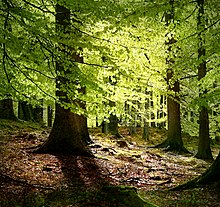
Denmark belongs to theBoreal Kingdomand can be subdivided into twoecoregions:theAtlantic mixed forestsandBaltic mixed forests.[63][64]Almost all of Denmark'sprimeval temperate forestshave been destroyed or fragmented, chiefly for agricultural purposes during the last millennia.[65]The deforestation has created large swaths ofheathlandand devastatingsand drifts.[65]In spite of this, there are several largersecond growth woodlandsin the country and, in total, 12.9% of the land is now forested.[66]Norway spruceis the most widespread tree (2017); an important tree in theChristmas tree production.Denmark holds aForest Landscape Integrity Indexmean score of 0.5/10, ranking it 171st globally out of 172 countries—behind onlySan Marino.[67][further explanation needed]
Roe deeroccupy the countryside in growing numbers, and large-antleredred deercan be found in the sparse woodlands of Jutland. Denmark is also home to smaller mammals, such aspolecats,haresandhedgehogs.[68]Approximately 400 bird species inhabit Denmark and about 160 of those breed in the country.[69]Large marine mammals include healthy populations ofHarbour porpoise,growing numbers ofpinnipedsand occasional visits of large whales, includingblue whalesandorcas.Cod,herringandplaiceare abundantculinary fishin Danish waters and form the basis fora large fishing industry.[70]
Environment

Denmark stopped issuing new licences for oil and gas extraction in December 2020.[71]
Land andwater pollutionare two of Denmark's most significantenvironmental issues,although much of the country's household and industrial waste is now increasingly filtered and sometimes recycled. The country has historically taken a progressive stance onenvironmental preservation;in 1971 Denmark established aMinistry of Environmentand was the first country in the world to implement anenvironmental lawin 1973.[72]To mitigate environmental degradation andglobal warmingthe Danish Government has signed theClimate Change-Kyoto Protocol.[73]However, the nationalecological footprintis 8.26 global hectares per person, which is very high compared to a world average of 1.7 in 2010.[74]Contributing factors to this value are an exceptional high value for cropland but also a relatively high value for grazing land,[75]which may be explained by the substantially high meat production in Denmark (115.8 kilograms (255 lb) meat annually per capita) and the large economic role of the meat and dairy industries.[76]In December 2014, theClimate Change Performance Indexfor 2015 placed Denmark at the top of the table, explaining that although emissions are still quite high, the country was able to implement effective climate protection policies.[77]In 2020, Denmark was placed first in the index again.[78]In 2021 Denmark, with Costa Rica, launched the "Beyond Oil and Gas alliance" for stopping use fossil fuels.[79]
Denmark's territories, Greenland and theFaroe Islands,catch approximately 650 whales per year.[80][81]Greenland's quotas for the catch of whales are determined according to the advice of theInternational Whaling Commission(IWC), having quota decision-making powers.[82]
Government and politics
Politics in Denmark operate under a framework laid out in theConstitution of Denmark.[N 11]First written in 1849, it establishes a sovereign state in the form of aconstitutional monarchy,with a representativeunicameralparliamentary system.Themonarchofficially retainsexecutive powerand presides over theCouncil of State(privy council).[84][85]In practice, the duties of the monarch are strictly representative andceremonial,[N 12][86]such as the formal appointment and dismissal of thePrime Ministerand other Government ministers. The Monarch is not answerable for his or her actions, and theirpersonissacrosanct.[87]Hereditary monarchKing Frederik Xhas been head of state since 14 January 2024.[88]
Government

The Danish parliament isunicameraland called the Folketing (Danish:Folketinget). It is thelegislatureof the Kingdom of Denmark, passingactsthat apply in Denmark and, variably, Greenland and the Faroe Islands. The Folketing is also responsible for adopting thestate's budgets,approving the state's accounts, appointing and exercising control of the Government, and taking part in international co-operation.Billsmay be initiated by the Government or bymembers of parliament.All bills passed must be presented before the Council of State to receiveRoyal Assentwithin thirty days in order to become law.[89]

Denmark is arepresentative democracywithuniversal suffrage.[N 13]Membership of the Folketing is based onproportional representationof political parties,[91]with a 2% electoral threshold. Denmark elects 175 members to the Folketing, with Greenland and the Faroe Islands electing an additional two members each—179 members in total.[92]Parliamentary elections are held at least every four years, but it is within the powers of the prime minister to ask the monarch to call for an election before the term has elapsed. On avote of no confidence,the Folketing may force a single minister or an entire government to resign.[93]
The Government of Denmark operates as acabinet government,where executive authority is exercised—formally, on behalf of the monarch—by the prime minister and othercabinet ministers,who headministries.As the executive branch, the Cabinet is responsible for proposing bills and a budget, executing the laws, and guiding the foreign and internal policies of Denmark. The position of prime minister belongs to the person most likely to command theconfidenceof a majority in the Folketing; this is often the current leader of the largestpolitical partyor, more effectively, through acoalition of parties.A single party generally does not have sufficient political power in terms of the number of seats to form a cabinet on its own; Denmark has often been ruled bycoalition governments,themselves usuallyminority governmentsdependent on non-government parties.[94]
Following the2022 Danish general electionin November 2022, resident prime minister andSocial Democratic leaderMette Frederiksenin December 2022 formed the currentFrederiksen II Cabinet,a coalition government with the until then leading opposition partyVenstreand the recently foundedModerate party.[95]
Law and judicial system

Denmark has acivil lawsystem with some references toGermanic law.Denmark resembles Norway and Sweden in never having developed acase-lawlike that ofEnglandand theUnited Statesnor comprehensivecodeslike those of France and Germany. Much of its law iscustomary.[96]
The judicial system of Denmark is divided between courts with regular civil andcriminaljurisdiction and administrative courts with jurisdiction over litigation between individuals and the public administration. Articles sixty-two and sixty-four of the Constitution ensurejudicial independencefrom government and Parliament by providing that judges shall only be guided by the law, including acts, statutes and practice.[97]The Kingdom of Denmark does not have a single unified judicial system – Denmark has one system, Greenland another, and the Faroe Islands a third.[98]However, decisions by the highest courts in Greenland and the Faroe Islands may be appealed to the Danish High Courts. TheDanish Supreme Courtis the highest civil and criminal court responsible for the administration of justice in the Kingdom.
Danish Realm
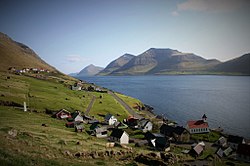
The Kingdom of Denmark is aunitary statethat comprises, in addition to metropolitan Denmark, twoautonomous territories[13]in theNorth Atlantic Ocean:theFaroe IslandsandGreenland.They have been integrated parts of the Danish Realm since the 18th century; however, due to their separate historical and cultural identities, these parts of the Realm have extensive political powers and have assumedlegislativeand administrative responsibility in a substantial number of fields.[99]Home rulewas granted to the Faroe Islands in 1948 and to Greenland in 1979, each having previously had the status ofcounties.[100]
The Faroe Islands and Greenland have their own home governments and parliaments and are effectivelyself-governingin regards to domestic affairs apart from the judicial system and monetary policy.[100]High Commissioners(Rigsombudsmand) act as representatives of the Danish government in the FaroeseLøgtingand in theGreenlandic Parliament,but they cannot vote.[100]The Faroese home government is defined to be an equal partner with the Danish national government,[101]while theGreenlandic peopleare defined as a separate people with the right toself-determination.[102]
| Autonomous territory | Population(2020) | Total area | Capital | Local parliament | Premier |
|---|---|---|---|---|---|
| 52,110[103] | 1,399 km2(540.16 sq mi) | Løgting | Aksel V. Johannesen | ||
| 56,081[104] | 2,166,086 km2(836,330 sq mi) | Inatsisartut | Múte Bourup Egede |
Administrative divisions
Denmark, with a total area of 43,094square kilometres(16,639 sq mi), is divided into five administrative regions (Danish:regioner). The regions are further subdivided into98 municipalities(kommuner). The easternmost land in Denmark, theErtholmenearchipelago, with an area of 39 hectares (0.16 sq mi), is neither part of a municipality nor a region but belongs to theMinistry of Defence.[105]Theprovinces of Denmarkare statistical divisions of Denmark, positioned between theadministrative regionsandmunicipalities.They are not administrative divisions, nor subject for any kind of political elections, but are mainly for statistical use.
The regions were created on1 January 2007to replace the 16former counties.At the same time, smaller municipalities were merged into larger units, reducing the number from 270. Most municipalities have a population of at least 20,000 to give them financial and professional sustainability, although a few exceptions were made to this rule.[106]The administrative divisions are led by directly elected councils, elected proportionally every four years; the most recentDanish local electionswere held on 16 November 2021. Other regional structures use the municipal boundaries as a layout, including thepolice districts,thecourt districtsand theelectoral wards.
Regions
The governing bodies of the regions are theregional councils,each with forty-one councillors elected for four-year terms. The councils are headed by regional district chairmen (regionsrådsformand), who are elected by the council.[107] The areas of responsibility for the regional councils are thenational health service,social servicesandregional development.[107][108]Unlike the counties they replaced, the regions are not allowed to levy taxes and the health service is partly financed by a national health care contribution until 2018 (sundhedsbidrag), partly by funds from both government and municipalities.[109]From 1 January 2019 this contribution will be abolished, as it is being replaced by higher income tax instead.
Theareaand populations of the regions vary widely; for example, theCapital Regionhas a population three times larger than that ofNorth Denmark Region.Under the county system certain densely populated municipalities, such asCopenhagen MunicipalityandFrederiksberg,had been given a status equivalent to that of counties, making them first-level administrative divisions. Thesesui generismunicipalities were incorporated into the new regions under the 2007 reforms.
| Danishname | English name | Admin. centre | Largest city (populous) |
Population (April 2021) |
Total area (km2) |
|---|---|---|---|---|---|
| Hovedstaden | Capital Region of Denmark | Hillerød | Copenhagen | 1,856,061 | 2,568.29 |
| Midtjylland | Central Denmark Region | Viborg | Aarhus | 1,333,245 | 13,095.80 |
| Nordjylland | North Denmark Region | Aalborg | Aalborg | 590,322 | 7,907.09 |
| Sjælland | Region Zealand | Sorø | Roskilde | 839,619 | 7,268.75 |
| Syddanmark | Region of Southern Denmark | Vejle | Odense | 1,224,100 | 12,132.21 |
| Source:Regional and municipal key figures | |||||
Foreign relations

Denmark wields considerable influence in Northern Europe and is amiddle powerin international affairs.[110]In recent years, Greenland and the Faroe Islands have been guaranteed a say in foreign policy issues such as fishing,whaling,and geopolitical concerns. The foreign policy of Denmark is substantially influenced byits membershipof theEuropean Union(EU); Denmark including Greenland joined theEuropean Economic Community(EEC), the EU's predecessor, in 1973.[N 14]Denmark held thePresidency of the Council of the European Unionon seven occasions, most recently from January to June 2012.[111]Following World War II, Denmark ended its two-hundred-year-long policy ofneutrality.It has been a founding member of theNorth Atlantic Treaty Organization(NATO) since 1949, and membership remains highly popular.[112]
As a member ofDevelopment Assistance Committee(DAC), Denmark has for a long time been among the countries of the world contributing the largest percentage of gross national income todevelopment aid.In 2015, Denmark contributed 0.85% of itsgross national income(GNI) toforeign aidand was one of only six countries meeting the longstanding UN target of 0.7% of GNI.[N 15][113]The country participates in both bilateral and multilateral aid, with the aid usually administered by theMinistry of Foreign Affairs.The organisational name ofDanish International Development Agency(DANIDA) is often used, in particular when operating bilateral aid. According to the 2024Global Peace Index,Denmark is the 8th most peaceful country in the world.[114]
Military

Denmark'sarmed forcesare known as theDanish Defence(Danish:Forsvaret). The Minister of Defence iscommander-in-chiefof the Danish Defence, and serves as chiefdiplomaticofficial abroad. During peacetime, theMinistry of Defenceemploys around 33,000 in total. The main military branches employ almost 27,000: 15,460 in theRoyal Danish Army,5,300 in theRoyal Danish Navyand 6,050 in theRoyal Danish Air Force(all including conscripts).[citation needed]TheDanish Emergency Management Agencyemploys 2,000 (including conscripts), and about 4,000 are in non-branch-specific services like theDanish Defence Commandand theDanish Defence Intelligence Service.Furthermore, around 44,500 serve as volunteers in theDanish Home Guard.[115]
Denmark is a long-time supporter of internationalpeacekeeping,but since theNATO bombing of Yugoslaviain 1999 and theWar in Afghanistanin 2001, Denmark has also found a new role as a warring nation, participating actively in several wars and invasions. This relatively new situation has stirred some internal critique, but the Danish population has generally been very supportive, in particular of the War in Afghanistan.[116][117]The Danish Defence has around 1,400[118]staff in international missions, not including standing contributions toNATO SNMCMG1.Danish forces were heavily engaged in the former Yugoslavia in the UN Protection Force (UNPROFOR), withIFOR,[119]and nowSFOR.[120]Between 2003 and 2007, there were approximately 450 Danish soldiers inIraq.[121]Denmark also strongly supportedAmerican operationsinAfghanistanand has contributed both monetarily and materially to theISAF.[122]These initiatives are often described by the authorities as part of a new "active foreign policy" of Denmark.
Economy

Denmark has adevelopedmixed economythat is classed as ahigh-income economyby theWorld Bank.[123]In 2017, it ranked 16th in the world in terms ofgross national income (PPP) per capitaand 10th innominal GNI per capita.[124]Denmark's economy stands out as one of the most free in theIndex of Economic Freedomand theEconomic Freedom of the World.[125][126]It is the 10th most competitive economy in the world, and 6th in Europe, according to theWorld Economic Forumin itsGlobal Competitiveness Report 2018.[127]
Denmark has the fourth highest ratio oftertiary degreeholders in the world.[128]The country ranks highest in the world forworkers' rights.[129]GDP per hour worked was the 13th highest in 2009. The country has a market income inequality close to theOECDaverage,[130][131]but after taxes and public cash transfers the income inequality isconsiderably lower.According toEurostat,Denmark'sGini coefficientfor disposable income was the 7th-lowest among EU countries in 2017.[132] According to theInternational Monetary Fund,Denmark hasthe world's highest minimum wage.[133]As Denmark has no minimum wage legislation, the high wage floor has been attributed to the power oftrade unions.For example, as the result of a collective bargaining agreement between the3F trade unionand the employers groupHoresta,workers atMcDonald'sand otherfast food chainsmake the equivalent ofUS$20 an hour, which is more than double what their counterparts earn in the United States, and have access to paid vacation,parental leaveand a pension plan.[134]Union density in 2015 was 68%.[135]
Once a predominantlyagriculturalcountry on account of itsarablelandscape, since 1945 Denmark has greatly expanded itsindustrial baseandservice sector.By 2017 services contributed circa 75% of GDP, manufacturing about 15% and agriculture less than 2%.[136]Major industries includewind turbines,pharmaceuticals,medical equipment,machineryand transportation equipment,food processing,andconstruction.[137]Circa 60% of the total export value is due to export of goods, and the remaining 40% is from service exports, mainly sea transport. The country's main export goods are: wind turbines, pharmaceuticals, machinery and instruments, meat and meat products, dairy products, fish, furniture and design.[137]Denmark is a net exporter of food and energy and has for a number of years had abalance of paymentssurplus which has transformed the country from a net debitor to a net creditor country. By 1 July 2018, thenet international investment position(ornet foreign assets) of Denmark was equal to 64.6% of GDP.[138]
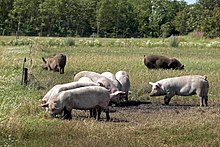
Denmark is part of theEuropean Union'sinternal market,which represents more than 508 million consumers. Several domestic commercial policies are determined by agreements among European Union (EU) members and by EU legislation. Support forfree tradeis high among the Danish public; in a 2016 poll 57% responded saw globalisation as an opportunity whereas 18% viewed it as a threat.[139]70% of trade flows are inside the European Union. As of 2017[update],Denmark's largest export partners are Germany, Sweden, the United Kingdom and the United States.[73]
Denmark's currency, thekrone(DKK), ispeggedat approximately 7.46 kroner per euro through theERM II.Although aSeptember 2000 referendumrejected adopting theeuro,[140]the country follows the policies set forth in theEconomic and Monetary Union of the European Union(EMU) and meets the economicconvergence criterianeeded to adopt the euro. The majority of the political parties in the Folketing support joining the EMU, but since 2010 opinion polls have consistently shown a clear majority against adopting the euro. In March 2018, 29% of respondents from Denmark in aEurobarometeropinion poll stated that they were in favour of the EMU and the euro, whereas 65% were against it.[141]The exact same pole conducted in November 2023, was almost unchanged with 31% in favour and 63% against.[142]
Ranked by turnover in Denmark, the largest Danish companies are:A.P. Møller-Mærsk(international shipping),Novo Nordisk(pharmaceuticals),ISS A/S(facility services),Vestas(wind turbines),Arla Foods(dairy),DSV(transport),Carlsberg Group(beer),Salling Group(retail),Ørsted A/S(power),Danske Bank.[143]
The Danish government focused into methods to increasetaxesonenergydealers in 2023.[144]
Public policy
Danes enjoy a high standard of living and the Danish economy is characterised by extensive governmentwelfare provisions.Denmark has acorporate taxrate of 22% and a special time-limited tax regime for expatriates.[145]The Danish taxation system is broad based, with a 25%value-added tax,in addition to excise taxes, income taxes and other fees. The overall level of taxation (sum of all taxes, as a percentage of GDP) was 46% in 2017.[146]The tax structure of Denmark (the relative weight of different taxes) differs from the OECD average, as the Danish tax system in 2015 was characterised by substantially higher revenues from taxes on personal income and a lower proportion of revenues from taxes on corporate income and gains and property taxes than in OECD generally, whereas no revenues at all derive from social security contributions. The proportion deriving from payroll taxes, VAT, and other taxes on goods and services correspond to the OECD average[147]
As of 2014[update],6% of the population was reported to live below thepoverty line,when adjusted for taxes and transfers. Denmark had the 2nd lowest relative poverty rate in theOECD,below the 11.3% OECD average.[148]The 6% of the population reporting that they could not afford to buy sufficient food was less than half of the OECD average.[148]
Labour market
Like other Nordic countries, Denmark has adopted theNordic Model,which combinesfree marketcapitalism with a comprehensivewelfare stateand strongworker protection.[149]As a result of its acclaimed "flexicurity"model, Denmark has the freestlabour marketin Europe, according to the World Bank. Employers can hire and fire whenever they want (flexibility), and between jobs,unemploymentcompensation is relatively high (security). According to OECD, initial as well as long-term net replacement rates for unemployed persons were 65% of previous net income in 2016, against an OECD average of 53%.[150]No restrictions apply regarding overtime work, which allows companies to operate 24 hours a day, 365 days a year.[151]With an employment rate in 2017 of 74.2% for people aged 15–64-years, Denmark ranks 9th highest among the OECD countries, and above the OECD average of 67.8%.[152]The unemployment rate was 5.7% in 2017,[153]which is considered close to or below its structural level.[154]
The level ofunemployment benefitsis dependent on former employment and normally on membership of an unemployment fund, which is usually closely connected to a trade union, and previous payment of contributions. Circa 65% of the financing comes from earmarked member contributions, whereas the remaining third originates from the central government and hence from general taxation.[155]
Business
Establishing a business in Denmark can be undertaken in a matter of hours and at very low costs.[156]The Danish government operates a "Danish Business Authority", and launched a series of initiatives in 2012 aiming to simplify business rules, making it easier to run a business without jeopardizing the intended goals of relevant legislation.[157]
Science and technology

Denmark has a long tradition of scientific and technological invention and engagement, and has been involved internationally from the very start of thescientific revolution.In current times, Denmark is participating in many high-profile international science and technology projects, includingCERN,ITER,ESA,ISSandE-ELT.Denmark was ranked 9th in theGlobal Innovation Indexin 2023, down from 6th in 2020 and from 7th in 2019.[159][160][161][162]
In the 20th century, Danes have also been innovative in several fields of the technology sector. Danish companies have been influential in the shipping industry with the design of the largest and most energy efficient container ships in the world, theMaersk Triple E class,and Danish engineers have contributed to the design ofMAN Dieselengines. In the software and electronic field, Denmark contributed to design and manufacturing ofNordic Mobile Telephones,and the now-defunct Danish companyDanCallwas among the first to developGSMmobile phones.
Life scienceis a key sector with extensive research and development activities. Danish engineers are world-leading in providingdiabetescare equipment and medication products from Novo Nordisk and, since 2000, the DanishbiotechcompanyNovozymes,the world market leader in enzymes for first generation starch-basedbioethanol,has pioneered development of enzymes for converting waste tocellulosic ethanol.[163]Medicon Valley,spanning theØresund Regionbetween Zealand and Sweden, is one of Europe's largest life scienceclusters.
Danish-born computer scientists and software engineers have taken leading roles in some of the world's programming languages:Anders Hejlsberg(Turbo Pascal,Delphi,C#);Rasmus Lerdorf(PHP);Bjarne Stroustrup(C++);David Heinemeier Hansson(Ruby on Rails);Lars Bak,a pioneer in virtual machines (V8,Java VM,Dart). PhysicistLene Vestergaard Hauis the first person to stop light, leading to advances inquantum computing,nanoscale engineering,andlinear optics.
Energy
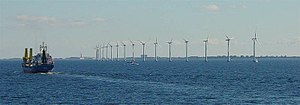
Denmark has considerably large deposits of oil and natural gas in theNorth Seaand ranks as number 32 in the world among net exporters ofcrude oil[164]and was producing 259,980 barrels of crude oil a day in 2009.[165]Denmark is a long-time leader inwind power:In 2015wind turbinesprovided 42.1% of the total electricity consumption.[166]In May 2011[update]Denmark derived 3.1% of its gross domestic product from renewable (clean) energy technology and energy efficiency, or around €6.5 billion ($9.4 billion).[167]Denmark is connected byelectric transmission linesto other European countries.
Denmark's electricity sectorhas integrated energy sources such as wind power into the national grid. Denmark now aims to focus on intelligent battery systems (V2G) andplug-in vehiclesin the transport sector.[168]The country is a member nation of theInternational Renewable Energy Agency(IRENA).[169]
Denmark exported roughly 460 millionGJof energy in 2018.[170]
Transport
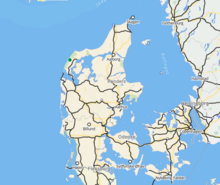

Significant investment has been made in building road and rail links between regions in Denmark, most notably theGreat Belt Fixed Link,which connectsZealandandFunen.It is now possible to drive fromFrederikshavnin northernJutlandtoCopenhagenon eastern Zealand without leaving the motorway. The main railway operator isDSBfor passenger services andDB Cargofor freight trains. The railway tracks are maintained byBanedanmark.The North Sea and the Baltic Sea are intertwined by various, international ferry links. Construction of theFehmarn Belt Fixed Link,connecting Denmark and Germany with a second link, Started in 2021.[172]Copenhagen has arapid transitsystem, theCopenhagen Metro,and an extensive electrified suburban railway network, theS-train.In the four largest cities –Copenhagen,Aarhus,Odense,Aalborg–light railsystems are planned to be in operation around 2020.[173]
Cycling in Denmarkis a very common form of transport, particularly for the young and for city dwellers. With a network of bicycle routes extending more than 12,000 km[174]and an estimated 7,000 km[175]ofsegregated dedicated bicycle paths and lanes,Denmark has a solidbicycle infrastructure.
Private vehicles are increasingly used as a means of transport. Because of thehigh registration tax(150%),VAT(25%), and one of the world's highest income tax rates, new cars are very expensive. The purpose of the tax is to discourage car ownership. In 2007, an attempt was made by the government to favour environmentally friendly cars by slightly reducing taxes on high mileage vehicles. However, this has had little effect, and in 2008 Denmark experienced an increase in the import of fuel inefficient old cars,[176]as the cost for older cars—including taxes—keeps them within the budget of many Danes. As of 2011[update],the average car age is 9.2 years.[177]
With Norway and Sweden, Denmark is part of theScandinavian Airlinesflag carrier.Copenhagen Airportis Scandinavia's busiest passenger airport, handling over 25 million passengers in 2014.[171]Other notable airports areBillund Airport,Aalborg Airport,andAarhus Airport.
Demographics
Population by ancestry (Q2 2020):[12]
Population
The population of Denmark, as registered byStatistics Denmark,was 5.825 million in April 2020.[12]Denmark has one of the oldest populations in the world, with the average age of 41.9 years,[178]with 0.97 males per female. Despite a low birth rate, the population is growing at an average annual rate of 0.59%[137]because of net immigration and increasing longevity. TheWorld Happiness Reportfrequently ranks Denmark's population as the happiest in the world.[179][180][181]This has been attributed to the country's highly regarded education andhealth caresystems,[182]and its low level ofincome inequality.[183]People in Denmark feel responsible forsocial welfare.The rate of taxation is among the world's highest and can be half a Dane's income but they get most healthcare free, university tuition is also free and students get grants, there is subsidized childcare and old people get pensions and care helpers.[184]
Denmark is a historicallyhomogeneousnation.[185]However, as with its Scandinavian neighbours, Denmark has recently transformed from a nation ofnet emigration,up until World War II, to a nation of net immigration. Today,residence permitsare issued mostly to immigrants from other EU countries (54% of all non-Scandinavian immigrants in 2017). Another 31% of residence permits were study- or work-related, 4% were issued toasylum seekersand 10% to persons who arrive as family dependants.[186]Overall, the net migration rate in 2017 was 2.1 migrant(s)/1,000 population, somewhat lower than the United Kingdom and the other Nordic countries.[137][187][188]
There are no official statistics onethnic groups,but according to 2020 figures from Statistics Denmark, 86.11% of the population in Denmark was ofDanishdescent (includingFaroeseandGreenlandic), defined as having at least one parent who was born in theKingdom of Denmarkand holdsDanish nationality.[12][N 5]The remaining 13.89% were of foreign background, defined as immigrants or descendants of recent immigrants. With the same definition, the most common countries of origin wereTurkey,Poland,Syria,Germany,Iraq,Romania,Lebanon,Pakistan,Bosnia and Herzegovina,andSomalia.[12]Minorities in Denmark includeTurks,Poles,Syrians,Germans,Iraqis,Romaniansand people from formerYugoslavia.There are also other Asian and African populations in the country. Small numbers ofRomani peopleandHungarianslive in Denmark. There is also a smallJewishpopulation.[189]
TheInuitare Indigenous to Greenland in the Kingdom and have traditionally inhabited Greenland and the northern parts of Canada and Alaska in theArctic.From the 18th century up to the 1970s, the Danish government (Dano-Norwegian until 1814) tried to assimilate the Greenlandic Inuit, encouraging them to adopt the majority language and culture. Because of this "Danization process", some persons of Inuit ancestry now identify their mother tongue as Danish.
Largest cities in Denmark (as of 1 January 2016[update])
| ||||||||||
|---|---|---|---|---|---|---|---|---|---|---|
| Rank | Core City | Region | Urban Population | Municipal Population | ||||||
| 1 | København | Capital Region of Denmark | 1,280,371 | 591,481 | ||||||
| 2 | Aarhus | Central Denmark Region | 264,716 | 330,639 | ||||||
| 3 | Odense | Region of Southern Denmark | 175,245 | 198,972 | ||||||
| 4 | Aalborg | North Denmark Region | 112,194 | 210,316 | ||||||
| 5 | Esbjerg | Region of Southern Denmark | 72,151 | 115,748 | ||||||
| 6 | Randers | Central Denmark Region | 62,342 | 97,520 | ||||||
| 7 | Kolding | Region of Southern Denmark | 59,712 | 91,695 | ||||||
| 8 | Horsens | Central Denmark Region | 57,517 | 87,736 | ||||||
| 9 | Vejle | Region of Southern Denmark | 54,862 | 111,743 | ||||||
| 10 | Roskilde | Region Zealand | 50,046 | 86,207 | ||||||
| Source:Statistics Denmark | ||||||||||
Languages
Danishis thede factonational languageof Denmark.[190]FaroeseandGreenlandicare the official languages of the Faroe Islands and Greenland respectively.[190]Germanis a recognisedminority languagein the area of the formerSouth Jutland County(now part of theRegion of Southern Denmark), which was part of the German Empire prior to theTreaty of Versailles.[190]Danish and Faroese belong to theNorth Germanic(Nordic) branch of theIndo-European languages,along withIcelandic,Norwegian,andSwedish.[191]There is some degree ofmutual intelligibility between Danish, Norwegian, and Swedish.Danish is more distantly related to German, which is aWest Germaniclanguage. Greenlandic or "Kalaallisut" is anInuit language,and is entirely unrelated to Danish,[191]although it has adopted many Danishloanwordsincluding the words for numbers.
A large majority (86%) of Danes speakEnglishas a second language,[192]generally with a high level ofproficiency.German is the second-most spoken foreign language, with 47% reporting a conversational level of proficiency.[190]Denmark had 25,900native speakersof German in 2007 (mostly in the South Jutland area).[190]
Religion
Christianityis the dominant religion in Denmark. As of 2024, 71.2%[193]of the population of Denmark were members of theChurch of Denmark(Den Danske Folkekirke), theofficially establishedchurch, which isProtestantin classification andLutheranin orientation.[194][N 16]The membership percentage has been in steady decline since the 1970s, mainly as fewer newborns are beingbaptisedinto it.[195]Only 3% of the population regularly attend Sunday services[196][197]and only 19% of Danes consider religion to be an important part of their life.[198]
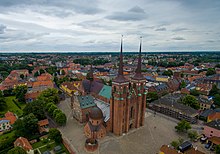
TheConstitutionstates that the sovereign must have the Lutheran faith, though the rest of the population is free to adhere to other faiths.[199][200][201]In 1682 the state granted limited recognition to three religious groups dissenting from the Established Church:Roman Catholicism,the Reformed ChurchandJudaism,[201]although conversion to these groups from the Church of Denmark remained illegal initially. Until the 1970s, the state formally recognised "religious societies" byroyal decree.Today, religious groups do not need official government recognition, they can be granted the right to perform weddings and other ceremonies without this recognition.[201]Denmark's Muslimsmake up approximately 4.4% of the population[202]and form the country's second largest religious community and largest minority religion.[203]The Danish Foreign Ministry estimates that other religious groups comprise less than 1% of the population individually and approximately 2% when taken all together.[204]
According to a 2010EurobarometerPoll,[205]28% of Danish nationals polled responded that they "believe there is a God", 47% responded that they "believe there is some sort of spirit or life force" and 24% responded that they "do not believe there is any sort of spirit, God or life force". Another poll, carried out in 2009, found that 25% of Danes believeJesusis theson of God,and 18% believe he is thesaviourof the world.[206]
Education

All educational programmes in Denmark are regulated by theMinistry of Educationand administered by local municipalities.Folkeskolecovers the entire period of compulsory education, encompassingprimaryand lowersecondary education.[207]Most children attendfolkeskolefor 10 years, from the ages of 6 to 16. There are no final examinations, but pupils can choose to sit an exam when finishingninth grade(14–15 years old). The test is obligatory if further education is to be attended. Alternatively pupils can attend anindependent school(friskole), or a private school (privatskole), such asChristian schoolsorWaldorf schools.
Following graduation from compulsory education, there are several continuing educational opportunities; theGymnasium (STX)attaches importance in teaching a mix of humanities and science,Higher Technical Examination Programme (HTX)focuses on scientific subjects and theHigher Commercial Examination Programmeemphasises on subjects in economics.Higher Preparatory Examination (HF)is similar toGymnasium (STX),but is one year shorter. For specific professions, there isvocational education,training young people for work in specifictradesby a combination of teaching andapprenticeship.
The government records upper secondary school completion rates of 95% andtertiaryenrollment and completion rates of 60%.[208]Alluniversityand college (tertiary) education in Denmark is free of charges; there are no tuition fees to enrol in courses. Students aged 18 or above may apply for state educational support grants, known asStatens Uddannelsesstøtte(SU),which provides fixed financial support, disbursed monthly.[209]Danish universities offer international students a range of opportunities for obtaining an internationally recognised qualification in Denmark. Many programmes may be taught in theEnglish language,the academiclingua franca,inbachelor's degrees,master's degrees,doctoratesandstudent exchange programmes.[210]
Health

As of 2015[update],Denmark has alife expectancyof 80.6 years at birth (78.6 for men, 82.5 for women), up from 76.9 years in 2000.[212]Thisranks it27th among 193 nations, behind the otherNordic countries.TheNational Institute of Public Healthof theUniversity of Southern Denmarkhas calculated 19 major risk factors among Danes that contribute to a lowering of the life expectancy; this includes smoking, alcohol,drug abuseandphysical inactivity.[213]Although theobesity rateis lower than in North America and most other European countries,[214]the large number ofoverweightDanes results in an annual additional consumption in the health care system ofDKK1,625 million.[213]In a 2012 study, Denmark had the highestcancer rateof all countries listed by the World Cancer Research Fund International; researchers suggest the reasons are better reporting, but also lifestyle factors like heavyalcohol consumption,smokingand physical inactivity.[215][216]
Denmark has auniversalhealth care system,characterised by being publicly financed through taxes and, for most of the services, run directly by the regional authorities. One of the sources of income was a national health care contribution (sundhedsbidrag) (2007–11:8%; '12:7%; '13:6%; '14:5%; '15:4%; '16:3%; '17:2%; '18:1%; '19:0%) but it was phased out from January 2019 in favor of income taxes.[109]This means that mosthealth care provisionis free at the point of delivery for all residents. Additionally, roughly two in five have complementaryprivate insuranceto cover services not fully covered by the state, such asphysiotherapy.[217]As of 2012[update],Denmark spends 11.2% of its GDP on health care; this is up from 9.8% in 2007 (US$3,512 per capita).[217]This places Denmark above theOECDaverage and above the other Nordic countries.[217][218]
Vulnerable residential areas

Certainsocial housingdistricts in Denmark fulfilling specific statistical criteria of relatively low employment, school attendance, relatively low income, a relatively low educational level or relatively many convicted inhabitants are officially listed by the government asvulnerable residential areas.In some cases, the majority of the neighbourhoods consist of non-Western immigrants and their descendants. Over the years, several government initiatives have been taken to further integration and counterurban decayin these neighbourhoods. Major plans to this end were presented in 1994 and 2000 by the governments ofPoul Nyrup Rasmussen,in 2004 by theAnders Fogh Rasmussen I Cabinet,in 2010 by theLars Løkke Rasmussen I Cabinet,in 2013 by theHelle Thorning-Schmidt I Cabinet,in 2018 by theLars Løkke Rasmussen III Cabinet,and in 2021 by theMette Frederiksen I Cabinet.[219][220][221]Some of the policies have been criticised for undercutting 'equality before law' and for portraying immigrants, especially Muslim immigrants, in a bad light.[222][223]
During the years 2010–2021, the term "ghetto"was used officially to designate some or all of the vulnerable areas.[222]The term was considered controversial, however, and removed in 2021.[224][225][226]Denmark is the only country to have officially used the word 'ghetto' in the 21st century to denote certain residential areas.[227]From 2021, four different lists are published, depending on the residents' income levels, employment status, education levels, criminal convictions and origin (a statistical criterion based on parents' geographical birthplace and citizenship).[228][222][229]In 2023, there were 19 vulnerable residential areas in Denmark.[230]
Culture
Denmark shares strong cultural andhistoricties with itsScandinavianneighboursSwedenandNorway.It has historically been one of the most socially progressive cultures in the world. In 1969, Denmark was the first country to legalisepornography,[231]and in 2012, Denmark replaced its "registered partnership"laws, which it had been the first country to introduce in 1989,[232][233]withgender-neutral marriage,and allowed same-sex marriages to be performed in theChurch of Denmark.[234][235]Modesty andsocial equalityare important parts of Danish culture.[236]In a 2016 study comparing empathy scores of 63 countries, Denmark ranked 4th world-wide having the highest empathy among surveyed European countries.[237]

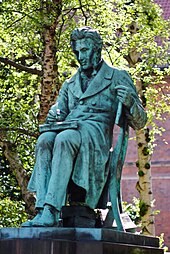
The astronomical discoveries ofTycho Brahe,Ludwig A. Colding's neglected articulation of the principle ofconservation of energy,and the contributions to atomic physics ofNiels Bohrindicate the range of Danish scientific achievement. The fairy tales ofHans Christian Andersen,the philosophical essays ofSøren Kierkegaard,the short stories ofKaren Blixen(pennameIsak Dinesen), the plays ofLudvig Holberg,and the dense, aphoristic poetry ofPiet Hein,have earned international recognition, as have the symphonies ofCarl Nielsen.From the mid-1990s, Danish films have attracted international attention, especially those associated withDogme 95like those ofLars von TrierandThomas Vinterberg.
A major feature of Danish culture isJul(DanishChristmas). The holiday is celebrated throughout December, starting either at the beginning of Advent or on 1 December with a variety of traditions, culminating with the Christmas Eve meal.
There are seven heritage sites inscribed on the UNESCOWorld Heritage list in Northern Europe:Christiansfeld,a Moravian Church Settlement, theJelling Mounds (Runic Stones and Church),Kronborg Castle,Roskilde Cathedral,andThe par force hunting landscape in North Zealandand 3 in theWorld Heritage list in North America:Ilulissat Icefjord,Aasivissuit—Nipisat,Kujataawithin the Kingdom of Denmark.[239]
Human rights
Denmark has been considered a progressive country, which has adopted legislation and policies to supportwomen's rights,minority rights, andLGBT rights.Human rights in Denmark are protected by the state's Constitution of theRealm(Danmarks Riges Grundlov);applying equally in Denmark proper,Greenlandand theFaroe Islands,and through theratificationof international human rights treaties.[240]Denmark has held a significant role in the adoption of both theEuropean Convention on Human Rightsand in the establishment of theEuropean Court of Human Rights(ECHR). In 1987, theKingdom Parliament(Folketinget) established a national human rights institution, the Danish Centre of Human Rights, now theDanish Institute for Human Rights.[240]
In 2009, a referendum on changing theDanish Act of Successionwere held to grantabsolute primogenitureto the Danish throne, meaning that the eldest child, regardless of gender, takes precedence in the line of succession. As it was not retroactive, the current successor to the throne is the eldest son of the King, rather than his eldest child. The Danish constitution Article 2 states that "The monarchy is inherited by men and women".[241]
The Inuit have for decades been the subject of discrimination and abuse by the dominant colonisers fromEurope,those countries claiming possession of Inuit lands. The Inuit have never been a single community in a single region ofInuit.[242]From the 18th century up to the 1970s, the Danish government (Dano-Norwegian until 1814) tried to assimilate theIndigenous peopleof Greenland, theGreenlandic Inuit,encouraging them to adopt the majority language, culture and religion.[243]Denmark has been greatly criticised by the Greenlandic community for the politics ofDanization(1950s and 1960s) of and discrimination against the Indigenous population of the country.[244][245]Critical treatment paying non-Inuit workers higher wages than the local people, the relocation of entire families from their traditional lands into settlements, and separating children from their parents and sending them away to Denmark for schooling has been practised.[245][246][247][248]Nevertheless, Denmark ratified, in 1996, to recognise theILO-convention 169onIndigenous peoplerecommended by the UN.
Denmark was the first country in the world to grant legal recognition to same-sex unions in the form ofregistered partnershipsin 1989. On 7 June 2012, the law was replaced by a newsame-sex marriage law,which came into effect on 15 June 2012.[249]Greenlandand theFaroe Islandslegalised same-sex marriage in April 2016,[250]and in July 2017 respectively.[251]In January 2016, a resolution was implemented by theDanish parliamentwhich preventedtransgenderidentity being classified as amental health condition.In doing so, Denmark became the first country inEuropeto go against theWorld Health Organisation (WHO)standards, which classified transgender identity as being a mental health issue until June 2018.[252][253]
Media
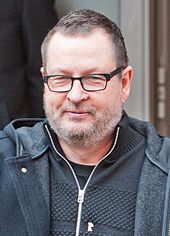
Danish cinema dates back to 1897 and since the 1980s has maintained a steady stream of productions due largely to funding by the state-supportedDanish Film Institute.There have been three big internationally important waves of Danish cinema: erotic melodrama of thesilent era;the increasingly explicit sex films of the 1960s and 1970s; and lastly, theDogme 95movement of the late 1990s, where directors often used hand-held cameras to dynamic effect in a conscious reaction against big-budget studios. Danish films have been noted for their realism, religious and moral themes, sexual frankness and technical innovation. The Danish filmmakerCarl Th. Dreyeris considered one of the greatest directors ofearly cinema.[254][255]
Other Danish filmmakers of note includeErik Balling,the creator of the popularOlsen-bandenfilms;Gabriel Axel,anOscar-winner forBabette's Feastin 1987; andBille August,theOscar-,Palme d'Or- andGolden Globe-winner forPelle the Conquerorin 1988. In the modern era, notable filmmakers in Denmark includeLars von Trier,who co-created the Dogme 95 movement withThomas Vinterberg,and multiple award-winnersSusanne BierandNicolas Winding Refn.Mads Mikkelsenis a world-renowned Danish actor, as isNikolaj Coster-Waldau.
Danishmass mediadate back to the 1540s, when handwritten fly sheets reported on the news. In 1666,Anders Bording,the father of Danish journalism, began astate paper.In 1834, the first liberal, factual newspaper appeared, and the 1849 Constitution established lastingfreedom of the press in Denmark.
Modern Danish mass media and news programming are dominated by a few large corporations. In printed mediaJP/Politikens HusandBerlingske Media,between them, control the largest newspapersPolitiken,Berlingske TidendeandJyllands-Postenand major tabloidsB.T.andEkstra Bladet.In television,publicly owned stationsDRandTV 2have large shares of the viewers.[256]DR in particular is famous for its high quality TV-series often sold to foreign broadcasters and often with leading female characters like internationally known actressesSidse Babett KnudsenandSofie Gråbøl.In radio, DR has a near monopoly, currently broadcasting on all four nationally availableFMchannels, competing only with local stations.[257]
Music
Denmark and its multiple outlying islands have awide range of folk traditions.The country's most famous classical composer isCarl Nielsen(1865–1931), especially remembered for his six symphonies and hisWind Quintet,while theRoyal Danish Balletspecialises in the work of the Danish choreographerAugust Bournonville.TheRoyal Danish Orchestrais among the world's oldest orchestras.[258]Danes have distinguished themselves asjazzmusicians, and theCopenhagen Jazz Festivalhas acquired international recognition.
The modernpopand rock scene has produced a few names of international fame, includingAqua,Alphabeat,D-A-D,King Diamond,Kashmir,Lukas Graham,Mew,Michael Learns to Rock,MØ,Oh Land,The RaveonettesandVolbeat,amongothers.Lars Ulrich,the drummer of the bandMetallica,has become the first Danish musician to be inducted into theRock and Roll Hall of Fame.
Roskilde Festivalnear Copenhagen is the largest music festival in Northern Europe since 1971 and Denmark has manyrecurring music festivalsof all genres throughout, includingAarhus International Jazz Festival,Skanderborg Festival,The Blue Festival in Aalborg, Esbjerg International Chamber Music Festival andSkagen Festivalamong many others.[259][260]
Denmark has participated in theEurovision Song Contestsince 1957 and has won the contest three times, in1963,2000and2013.
Architecture and design

Denmark's architecture became firmly established in theMiddle Ageswhen firstRomanesque,thenGothicchurches and cathedrals sprang up throughout the country. From the 16th century, Dutch and Flemish designers were brought to Denmark, initially to improve the country's fortifications, but increasingly to build magnificent royal castles and palaces in theRenaissancestyle. During the 17th century, many impressive buildings were built in theBaroquestyle, both in the capital and the provinces.Neoclassicismfrom France was slowly adopted by native Danish architects who increasingly participated in defining architectural style. A productive period ofHistoricismultimately merged into the 19th-centuryNational Romantic style.[261]
The 20th century brought along new architectural styles; includingexpressionism,best exemplified by the designs of architectPeder Vilhelm Jensen-Klint,which relied heavily on Scandinavian brick Gothic traditions; andNordic Classicism,which enjoyed brief popularity in the early decades of the century. It was in the 1960s that Danish architects such asArne Jacobsenentered the world scene with their highly successfulFunctionalist architecture.This, in turn, has evolved into more recent world-class masterpieces includingJørn Utzon'sSydney Opera HouseandJohan Otto von Spreckelsen'sGrande Archede la Défense in Paris, paving the way for a number of contemporary Danish designers such asBjarke Ingelsto be rewarded for excellence both at home and abroad.[262]
Danish design is a term often used to describe a style offunctionalisticdesign and architecture that was developed in the mid-20th century, originating in Denmark. Danish design is typically applied to industrial design, furniture and household objects, which have won many international awards. TheRoyal Porcelain Factoryis famous for the quality of its ceramics. Danish design is also a well-known brand, often associated with world-famous, 20th-century designers and architects such asBørge Mogensen,Finn Juhl,Hans Wegner,Arne Jacobsen,Poul HenningsenandVerner Panton.[263]Other designers of note includeKristian Solmer Vedelin the area of industrial design,Jens Quistgaardfor kitchen furniture and implements andOle Wanscherwho had a classical approach to furniture design.
Literature and philosophy

The first known Danish literature is myths andfolklorefrom the 10th and 11th century.Saxo Grammaticus,normally considered the first Danish writer, worked on a chronicle ofDanish history(Gesta Danorum). Very little is known of other Danish literature from theMiddle Ages.With theAge of EnlightenmentcameLudvig Holbergwhose comedy plays are still being performed.
In the late 19th century, literature was seen as a way to influence society. Known as theModern Breakthrough,this movement was championed byGeorg Brandes,Henrik Pontoppidan(awarded theNobel Prize in Literature) andJ. P. Jacobsen.Romanticisminfluenced the renowned writer and poetHans Christian Andersen,known for his stories andfairy tales,e.g.The Ugly Duckling,The Little MermaidandThe Snow Queen.In recent historyJohannes Vilhelm Jensenwas also awarded theNobel Prize for Literature.Karen Blixenis famous for her novels and short stories. Other Danish writers of importance areHerman Bang,Gustav Wied,William Heinesen,Martin Andersen Nexø,Piet Hein,Hans Scherfig,Klaus Rifbjerg,Dan Turèll,Tove Ditlevsen,Inger ChristensenandPeter Høeg.
Danish philosophy has a long tradition as part ofWestern philosophy.Perhaps the most influential Danish philosopher wasSøren Kierkegaard,the creator ofChristian existentialism.Kierkegaard had a few Danish followers, includingHarald Høffding,who later in his life moved on to join the movement ofpositivism.Another Danish philosopher of note isGrundtvig,whose philosophy gave rise to a new form of non-aggressive nationalism in Denmark, and who is also influential for his theological and historical works.
Painting and photography
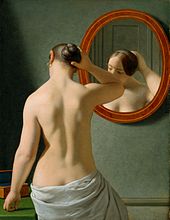
While Danish art was influenced over the centuries by trends in Germany and the Netherlands, the 15th and 16th centurychurch frescos,which can be seen in many of the country's older churches, are of particular interest as they were painted in a style typical of native Danish painters.[264]
TheDanish Golden Age,which began in the first half of the 19th century, was inspired by a new feeling of nationalism and romanticism, typified in the later previous century byhistory painterNicolai Abildgaard.Christoffer Wilhelm Eckersbergwas not only a productive artist in his own right but taught at theRoyal Danish Academy of Fine Artswhere his students includedWilhelm Bendz,Christen Købke,Martinus Rørbye,Constantin Hansen,andWilhelm Marstrand.
In 1871,Holger DrachmannandKarl MadsenvisitedSkagenin the far north ofJutlandwhere they quickly built up one of Scandinavia's most successfulartists' coloniesspecialising inNaturalismandRealismrather than in the traditional approach favoured by the academy. Hosted byMichaeland his wifeAnna,they were soon joined byP.S. Krøyer,Carl LocherandLaurits Tuxen.All participated in painting the natural surroundings and local people.[265]Similar trends developed on Funen with theFynboernewho includedJohannes Larsen,Fritz SybergandPeter Hansen,[266]and on the island of Bornholm with theBornholm school of paintersincludingNiels Lergaard,Kræsten IversenandOluf Høst.[267]
Painting has continued to be a prominent form of artistic expression in Danish culture, inspired by and also influencing major international trends in this area. These includeimpressionismand the modernist styles ofexpressionism,abstract paintingandsurrealism.While international co-operation and activity has almost always been essential to the Danish artistic community, influential art collectives with a firm Danish base includesDe Tretten(1909–1912),Linien(1930s and 1940s),COBRA(1948–1951),Fluxus(1960s and 1970s),De Unge Vilde(1980s) and more recentlySuperflex(founded in 1993). Notable Danish painters from modern times representing variousart movementsincludeTheodor Philipsen(impressionism and naturalism),Anna Klindt Sørensen(expressionism),Franciska Clausen(Neue Sachlichkeit, cubism, surrealism and others),Henry Heerup(naivism),Robert Jacobsen(abstract painting),Carl Henning Pedersen(abstract painting),Asger Jorn(Situationist, abstract painting),Bjørn Wiinblad(art deco, orientalism),Per Kirkeby(neo-expressionism, abstract painting),Per Arnoldi(pop art), andMichael Kvium(neo-surrealism).
Danish photography has developed from strong participation and interest in the very beginnings of theart of photographyin 1839. Pioneers such asMads AlstrupandGeorg Emil Hansenpaved the way for a rapidly growing profession during the last half of the 19th century. Today Danish photographers such asAstrid Kruse JensenandJacob Aue Sobolare active in key exhibitions around the world.[268]
Cuisine
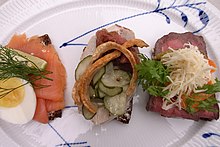
The traditionalcuisineof Denmark, like that of the other Nordic countries and ofNorthern Germany,consists mainly of meat, fish and potatoes. Danish dishes are highly seasonal, stemming from the country's agricultural past, its geography, and its climate of long, cold winters.
The open sandwiches on rye bread, known assmørrebrød,can be considered a national speciality. Hot meals traditionally consist ofground meats,such asfrikadeller(meat balls of veal and pork) andhakkebøf(minced beef patties), or of more substantial meat and fish dishes such asflæskesteg(roast pork with crackling) andkogt torsk(poached cod) with mustard sauce. Denmark is known for itsCarlsbergandTuborgbeers and for itsakvavitandbitters.
Since around 1970, chefs and restaurants across Denmark have introducedgourmetcooking, largely influenced byFrench cuisine.Also inspired by continental practices, Danish chefs have recently developed a new innovative cuisine and a series of gourmet dishes based on high-quality local produce known asNew Danish cuisine.[269]As a result of these developments, Denmark now has a considerable number of internationally acclaimed restaurants of which several have been awardedMichelin stars.This includesGeraniumandNomain Copenhagen.
Sports
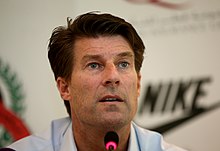
Sports are popular in Denmark, and its citizens participate in and watch a wide variety. Thenational sportisfootball,with over 320,000 players in more than 1600clubs.[270]Denmark qualified six times consecutively for theEuropean Championshipsbetween 1984 and 2004, and were crowned European champions in1992;other significant achievements include winning the Confederations Cup in 1995 and reaching the quarter-final of the 1998 World Cup. TheDenmark women's national handball teamcelebrated great successes during the 1990s and has won a total of 13 medals – seven gold (in 1994, 1996 (2), 1997, 2000, 2002 and 2004), four silver (in 1962, 1993, 1998 and 2004) and two bronze (in 1995 and 2013). On themen's side,Denmark has won 12 medals—four gold (in 2008, 2012, 2016 and 2019), four silver (in 1967, 2011, 2013 and 2014) and four bronze (in 2002, 2004, 2006 and 2007)—the most that have been won by any team inEuropean Handball Championshiphistory.[271]In 2019, the Danish men's national handball team won their firstWorld Championship title.[272][273]
In recent years, Denmark has made a mark as a strongcyclingnation, withMichael RasmussenreachingKing of the Mountainsstatus in theTour de Francein 2005 and 2006. Other popular sports include golf—which is mostly popular among those in the older demographic;[274]tennis—in which Denmark is successful on a professional level;basketball—Denmark joined the international governing bodyFIBAin 1951;[275]rugby—theDanish Rugby Uniondates back to 1950;[276]ice hockey—often competing in the top division in the Men's World Championships; rowing—Denmark specialise in lightweight rowing and are particularly known for their lightweight coxless four, having won six gold and two silver World Championship medals and three gold and two bronzeOlympicmedals; and several indoor sports—especiallybadminton,table tennisand gymnastics, in each of which Denmark holds World Championships andOlympic medals.
See also
Explanatory notes
- ^Kong Christianhas equal status as anational anthembut is generally used only onroyaland military occasions.[1]
- ^German is recognised as a protected minority language in the South Jutland area of Denmark.
- ^includingFaroese,Indigenous groupInuit,andminority groupGerman
- ^The Kingdom has a total population of 5,974,086.
- ^abcThis data is for Denmarkproperonly. For data relevant toGreenlandand theFaroe Islandssee their respective articles.
- ^In the Faroe Islands the currency has a separate design and is known as thekróna,but is not a separate currency.[citation needed]
- ^Thetop-level domain name.euis shared with otherEuropean Unioncountries.
- ^Danish:Kongeriget Danmark,pronounced[ˈkʰɔŋəʁiːð̩ˈtænmɑk].
- ^abThe Kingdom of Denmark's territory incontinental Europeis referred to as "metropolitanDenmark ",[53]"Denmarkproper"(Danish:egentlig Danmark), or simply "Denmark". In this article, usage of "Denmark" excludes theFaroe IslandsandGreenland.
- ^The island ofBornholmis offset to the east of the rest of the country, in the Baltic Sea.
- ^Denmark has acodified constitution.Changes to it require an absolute majority in two consecutive parliamentary terms and the approval of at least 40% of the electorate through a referendum.[83]
- ^The Constitution refers to "the King" (Danish:kongen), rather than the gender-neutral term "monarch". In light of the restriction of powers of the monarchy, this is best interpreted as referring to the government Cabinet.
- ^TheEconomist Intelligence Unit,while acknowledging that democracy is difficult to measure, listed Denmark 5th on itsindex of democracy.[90]
- ^The Faroese declined membership in 1973; Greenlandchose to leavethe EEC in 1985, followinga referendum.
- ^As measured inofficial development assistance(ODA). Denmark, Luxembourg, the Netherlands, Norway, Sweden and the United Kingdom exceeded the United Nations' ODA target of 0.7% of GNI.
- ^The Church of Denmark is the established church (or state religion) in Denmark and Greenland; theChurch of the Faroe Islandsbecame an independent body in 2007.
Citations
- ^"Not one but two national anthems".Ministry of Foreign Affairs of Denmark.Archivedfrom the original on 15 May 2014.Retrieved18 May2014.
- ^abcStone et al. (2008),p. 31.
- ^"Bekendtgørelse af ILO-konvention nr. 169 af 28. juni 1989 vedrørende oprindelige folk og stammefolk i selvstændige stater".Retsinformation.dk.9 October 1997.Archivedfrom the original on 8 October 2020.Retrieved30 September2020.
- ^"Den dansk-tyske mindretalsordning".UM.dk.Archivedfrom the original on 29 September 2020.Retrieved30 September2020.
- ^"Denmark".Central Intelligence Agency. 21 November 2023.Archivedfrom the original on 5 July 2021.Retrieved22 November2023.
- ^"Surface water and surface water change".Organisation for Economic Co-operation and Development(OECD).Archivedfrom the original on 24 March 2021.Retrieved11 October2020.
- ^"Population and population projections".Statistics Denmark. Archived fromthe originalon 30 October 2018.Retrieved11 August2022.
- ^abcd"World Economic Outlook Database, April 2024 Edition. (Denmark)".imf.org.International Monetary Fund.16 April 2024.Retrieved17 April2024.
- ^"Gini coefficient of equivalised disposable income – EU-SILC survey".ec.europa.eu.Eurostat.Archivedfrom the original on 9 October 2020.Retrieved25 November2023.
- ^"Human Development Report 2023/24"(PDF).United Nations Development Programme.13 March 2024. p. 288.Archived(PDF)from the original on 13 March 2024.Retrieved13 March2024.
- ^"Denmark Population 2024 (Live)".worldpopulationreview.Retrieved9 August2024.
- ^abcde"Population at the first day of the quarter by municipality, sex, age, marital status, ancestry, country of origin and citizenship".Statistics Denmark.Archivedfrom the original on 22 December 2022.Retrieved2 October2020.
January 2020
- ^ab*Benedikter, Thomas (19 June 2006)."The working autonomies in Europe".Society for Threatened Peoples.Archived fromthe originalon 9 March 2008.Retrieved8 June2012.
Denmark has established very specific territorial autonomies with its two island territories
- Ackrén, Maria (November 2017)."Greenland".Autonomy Arrangements in the World. Archived fromthe originalon 30 August 2019.Retrieved30 August2019.
Faroese and Greenlandic are seen as official regional languages in the self-governing territories belonging to Denmark.
- "Greenland".International Cooperation and Development.European Commission.3 June 2013.Archivedfrom the original on 16 September 2014.Retrieved27 August2019.
Greenland [...] is an autonomous territory within the Kingdom of Denmark
- Ackrén, Maria (November 2017)."Greenland".Autonomy Arrangements in the World. Archived fromthe originalon 30 August 2019.Retrieved30 August2019.
- ^"About Denmark".Archivedfrom the original on 27 December 2022.Retrieved27 December2022.
- ^ab"Area".Statistics Denmark.Archivedfrom the original on 14 April 2019.
- ^ab"Denmark in numbers 2010"(PDF).Statistics Denmark.Archived(PDF)from the original on 18 April 2013.Retrieved2 May2013.
- ^"Statistikbanken".statistikbanken.dk.Archivedfrom the original on 6 June 2023.Retrieved27 December2022.
- ^"Greenland and the Faroe Islands".Ministry of Foreign Affairs Denmark.Archivedfrom the original on 18 December 2023.Retrieved18 December2023.
- ^"Getting to Denmark".The New Republic.
- ^O'Sullivan, Mike."Has Europe Turned The Corner On Immigration?".Forbes.
- ^Kristian Andersen Nyrup, MiddelalderstudierBog IX. Kong Gorms SagaArchived9 January 2010 at theWayback Machine
- ^Indvandrerne i Danmarks historie,Bent Østergaard, Syddansk Universitetsforlag 2007,ISBN978-87-7674-204-1,pp. 19–24
- ^abJ. de Vries,Altnordisches etymologisches Wörterbuch,1962, 73;N. Å. Nielsen,Dansk etymologisk ordbog,1989, 85–96.
- ^Navneforskning, Københavns Universitet"Udvalgte stednavnes betydning".Archived fromthe originalon 16 July 2006.Retrieved27 January2008.
- ^O'Donoghue, Heather (2008).Old Norse-Icelandic Literature: A Short Introduction.John Wiley & Sons. p. 27.ISBN978-0-470-77683-4.Archivedfrom the original on 12 April 2016.Retrieved21 October2015.
- ^Michaelsen (2002),p. 19.
- ^abNielsen, Poul Otto (May 2003)."Denmark: History, Prehistory".Ministry of Foreign Affairs of Denmark.Archived fromthe originalon 22 November 2005.Retrieved1 May2006.
- ^Busck (2002),p. 20.
- ^Busck (2002),p. 19.
- ^Jordanes (22 April 1997)."The Origin and Deeds of the Goths, chapter III".Translated byCharles C. Mierow.Archivedfrom the original on 24 April 2006.Retrieved1 May2006.
- ^Michaelsen (2002),pp. 122–123.
- ^ab*Lund, Niels (May 2003)."Denmark – History – The Viking Age".Ministry of Foreign Affairs of Denmark.Archived fromthe originalon 10 May 2006.Retrieved24 June2012.
- ^Berend, Nora (22 November 2007).Christianization and the Rise of Christian Monarchy: Scandinavia, Central Europe and Rus' c.900–1200.Cambridge University Press.ISBN978-1-139-46836-7– via Google Books.
- ^Stone et al. (2008),p. 33.
- ^Lauring, Palle (1960)A History of the Kingdom of Denmark,Host & Son Co.: Copenhagen, p. 108.
- ^"Kalmarkriget 1611–1613".Svenskt Militärhistoriskt Bibliotek. Archived fromthe originalon 11 October 2007.Retrieved4 May2007.
- ^Rawlinson, Kevin (5 November 2018)."Prince Charles says Britain's role in slave trade was an atrocity".The Guardian.Archivedfrom the original on 5 November 2018.Retrieved6 November2018.
- ^Olson, James Stuart; Shadle, Robert, eds. (1991).Historical Dictionary of European Imperialism.Greenwood Publishing Group.ISBN978-0-313-26257-9.Retrieved15 May2014.
- ^Parker (1984),p. 78.
- ^Parker (1984),p. 79.
- ^Isacson (2002),p. 229.
- ^Englund (2000),p. 610.
- ^Stone et al. (2008),p. 35.
- ^Frost (2000),pp. 180–183.
- ^Ekman, Ernst (1957)."The Danish Royal Law of 1665".The Journal of Modern History.29(2): 102–107.doi:10.1086/237987.ISSN0022-2801.S2CID145652129.Archivedfrom the original on 23 January 2022.Retrieved27 March2021.
- ^"League of Armed Neutrality".Oxford Reference.Archivedfrom the original on 24 September 2015.Retrieved28 August2015.
- ^Jenssen-Tusch, Georg Friedrich (1852).Zur Regierungsgeschichte Friedrich VI. Königs von Dänemark, Herzogs von Schleswig, Holstein und Lauenburg(in German). Verlag Schröder. p. 166.
- ^Dörr, Oliver (2004).Kompendium völkerrechtlicher Rechtsprechung: eine Auswahl für Studium und Praxis.Tübingen: Mohr Siebeck. p. 101.ISBN978-3-16-148311-0.
- ^Tellier, Luc-Normand (2009).Urban world history an economic and geographical perspective.Québec: Presses de l'Université du Québec. p. 457.ISBN978-2-7605-2209-1.Archivedfrom the original on 12 April 2016.Retrieved21 October2015.
- ^"Lost in translation: Epic goes to Denmark".Politico.6 June 2019.Archivedfrom the original on 12 April 2020.Retrieved10 June2019.
- ^Rugg, Andy."Traitor Danes: most soldiers return heroes, but this lot came home total zeroes".Copenhagen Post.Archived fromthe originalon 29 January 2013.Retrieved30 January2013.
- ^"Finland: Now, the Seven and a Half".Time.7 April 1961. Archived fromthe originalon 4 November 2011.Retrieved18 July2009.
- ^Administrative divisions – DenmarkArchived25 March 2021 at theWayback MachineThe World Factbook.Access date: 16 September 2021
- ^"Facts and FiguresArchived30 June 2010 at theWayback Machine",Danish Defence, Defence Command Denmark. Retrieved 11 June 2010.
- ^abJensen 1999,p. 10.
- ^"Nature & Environment".Ministry of Foreign Affairs of Denmark.Archived fromthe originalon 3 April 2007.Retrieved3 February2007.
- ^Nationalencyklopedin, (1990)
- ^"Nyt højeste punkt i Danmark"(in Danish).Danish Geodata Agency.Archivedfrom the original on 28 May 2014.Retrieved26 May2014.
- ^ab"Climate Normals for Denmark".Danish Meteorological Institute.Archived fromthe originalon 3 January 2015.Retrieved2 January2015.Figures, labelled in Danish: First plot is the whole country; Nedbør=Precipitation, Nedbørdage=Precipitation days (>1 mm), (Dag/Middel/Nat)temp.=(Daytime/Average/Nighttime) temperature, Solskinstimer=Hours of sunshine.
- ^"Vejrekstremer i Danmark [Weather extremes in Denmark]"(in Danish).Danish Meteorological Institute(DMI). 6 October 2016. Archived fromthe originalon 19 October 2016.Retrieved19 October2016.
- ^"The weather cross – the four corners of autumn weather".Danish Meteorological Institute.Archived fromthe originalon 21 September 2015.Retrieved17 September2015.
- ^"Copenhagen, Denmark – Sunrise, sunset, dawn and dusk times for the whole year".Gaisma.Archivedfrom the original on 2 July 2012.Retrieved24 June2012.
- ^Dinerstein, Eric; Olson, David; Joshi, Anup; Vynne, Carly; Burgess, Neil D.; Wikramanayake, Eric; Hahn, Nathan; Palminteri, Suzanne; Hedao, Prashant; Noss, Reed; Hansen, Matt; Locke, Harvey; Ellis, Erle C.; Jones, Benjamin; Barber, Charles Victor; Hayes, Randy; Kormos, Cyril; Martin, Vance; Crist, Eileen; Sechrest, Wes; Price, Lori; Baillie, Jonathan E. M.; Weeden, Don; Suckling, Kierán; Davis, Crystal; Sizer, Nigel; Moore, Rebecca; Thau, David; Birch, Tanya; Potapov, Peter; Turubanova, Svetlana; Tyukavina, Alexandra; de Souza, Nadia; Pintea, Lilian; Brito, José C.; Llewellyn, Othman A.; Miller, Anthony G.; Patzelt, Annette; Ghazanfar, Shahina A.; Timberlake, Jonathan; Klöser, Heinz; Shennan-Farpón, Yara; Kindt, Roeland; Lillesø, Jens-Peter Barnekow; van Breugel, Paulo; Graudal, Lars; Voge, Maianna; Al-Shammari, Khalaf F.; Saleem, Muhammad (2017)."An Ecoregion-Based Approach to Protecting Half the Terrestrial Realm".BioScience.67(6): 534–545.doi:10.1093/biosci/bix014.ISSN0006-3568.PMC5451287.PMID28608869.
- ^Hogan, C. Michael."Ecoregions of Denmark".Encyclopedia of Earth.Archivedfrom the original on 24 September 2015.Retrieved26 August2015.
- ^abJensen, Christian Lundmark."Forests and forestry in Denmark – Thousands of years of interaction between man and nature"(PDF).Danish Ministry of the Environment Nature Agency. Archived fromthe original(PDF)on 15 July 2016.Retrieved31 May2016.
- ^"Forest area (% of land area)".worldbank.org.The World Bank.Archivedfrom the original on 5 September 2015.Retrieved26 August2015.
- ^Grantham, H. S.; Duncan, A.; Evans, T. D.; Jones, K. R.; Beyer, H. L.; Schuster, R.; Walston, J.; Ray, J. C.; Robinson, J. G.; Callow, M.; Clements, T.; Costa, H. M.; DeGemmis, A.; Elsen, P. R.; Ervin, J.; Franco, P.; Goldman, E.; Goetz, S.; Hansen, A.; Hofsvang, E.; Jantz, P.; Jupiter, S.; Kang, A.; Langhammer, P.; Laurance, W. F.; Lieberman, S.; Linkie, M.; Malhi, Y.; Maxwell, S.; Mendez, M.; Mittermeier, R.; Murray, N. J.; Possingham, H.; Radachowsky, J.; Saatchi, S.; Samper, C.; Silverman, J.; Shapiro, A.; Strassburg, B.; Stevens, T.; Stokes, E.; Taylor, R.; Tear, T.; Tizard, R.; Venter, O.; Visconti, P.; Wang, S.; Watson, J. E. M. (2020)."Anthropogenic modification of forests means only 40% of remaining forests have high ecosystem integrity – Supplementary Material".Nature Communications.11(1): 5978.Bibcode:2020NatCo..11.5978G.doi:10.1038/s41467-020-19493-3.ISSN2041-1723.PMC7723057.PMID33293507.
- ^"Animals in Denmark".listofcountriesoftheworld.2012.Archivedfrom the original on 1 June 2016.Retrieved31 May2016.
- ^"Bird list of Denmark".Netfugl.dk.Archivedfrom the original on 5 September 2015.Retrieved26 August2015.
It involves all category A, B and C birds recorded in Denmark (according to SU/BOURC/AERC standard).
- ^Byskov, Søren."Theme: Herring, cod and other fish – 1001 Stories of Denmark".The Heritage Agency of Denmark.Archivedfrom the original on 3 March 2016.Retrieved31 May2016.
- ^Farand, Chloé (4 December 2020)."Denmark to phase out oil and gas production by 2050 in" watershed "decision".Climate Home News.Archivedfrom the original on 4 December 2020.Retrieved29 December2020.
- ^The law of environmental damage: liability and reparation.Marie-Louise Larsson.
- ^ab"Denmark".The World Factbook.CIA. 19 January 2012.Archivedfrom the original on 5 July 2021.Retrieved4 February2012.
- ^"Ecological Footprint Atlas 2010".Global Footprint Network. 2010. Archived fromthe originalon 9 July 2011.Retrieved26 August2015.
- ^WWF (2014): Living Planet Report.
- ^AMI (2012); preliminary data for 2011
- ^Burck, Jan; Marten, Franziska; Bals, Christoph."The Climate Change Performance Index: Results 2015"(PDF).Germanwatch. Archived fromthe original(PDF)on 9 December 2014.Retrieved9 December2014.
- ^"2020 EPI Results".Environmental Performance Index.3 June 2020.Archivedfrom the original on 21 June 2023.Retrieved20 November2020.
- ^"Climate change: Whisper it cautiously... there's been progress in run up to COP26".BBC. 25 September 2021.Archivedfrom the original on 21 September 2022.Retrieved10 October2021.
- ^"Almost Saving Whales: The Ambiguity of Success at the International Whaling Commission [Full Text] – Ethics & International Affairs".Ethics & International Affairs.29 March 2012.Archivedfrom the original on 27 December 2017.Retrieved27 December2017.
- ^"Hundreds of whales slaughtered in Faroe Island's annual killing".The Independent.20 June 2017.Archivedfrom the original on 28 December 2017.Retrieved27 December2017.
- ^"Greenland quotas for big whales".Government of Greenland.5 January 2013. Archived fromthe originalon 5 November 2018.Retrieved4 November2018.
- ^Tschentscher, Axel."The Constitution of Denmark – Section 88".Servat.unibe.ch.Archivedfrom the original on 10 July 2011.Retrieved12 February2016.
- ^"The executive power is vested in the King."The Constitution of Denmark – Section 3.Archived10 July 2011 at theWayback Machine
- ^"The body of Ministers shall form the Council of State, in which the Successor to the Throne shall have a seat when he is of age. The Council of State shall be presided over by the King... "The Constitution of Denmark – Section 17.Archived10 July 2011 at theWayback Machine
- ^The Monarchy todayArchived15 February 2015 at theWayback Machine–The Danish Monarchy(kongehuset.dk). Access date: 16 June 2012
- ^"The King shall not be answerable for his actions; his person shall be sacrosanct."The Constitution of Denmark – Section 13.Archived10 July 2011 at theWayback Machine
- ^Bryant, Miranda (14 January 2024)."Denmark's King Frederik X takes throne after Margrethe abdicates".The Guardian.Archivedfrom the original on 21 February 2024.Retrieved19 February2024.
- ^"A Bill passed by the Parliament shall become law if it receives the Royal Assent not later than thirty days after it was finally passed."The Constitution of Denmark – Section 22.Archived10 July 2011 at theWayback Machine
- ^"Democracy Index 2014"(PDF).The Economist/Economist Intelligence Unit. 2015. Archived fromthe original(PDF)on 1 February 2016.Retrieved23 August2015.
- ^"ICL – Denmark – Constitution – Section 31. Elections".unibe.ch.Archivedfrom the original on 10 July 2011.Retrieved12 February2016.
- ^Jørgensen 1995,p. 16.
- ^"A Minister shall not remain in office after the Parliament has passed a vote of no confidence in him."The Constitution of Denmark – Section 15.Archived10 July 2011 at theWayback Machine
- ^"Radikale ved historisk skillevej".Berlingske Tidende.17 June 2007. Archived fromthe originalon 11 August 2011.Retrieved17 August2007.
- ^"Danish PM picks right-leaning rivals as key ministers in new government".Reuters.15 December 2022.Archivedfrom the original on 31 May 2023.Retrieved4 January2023.
- ^Orfield, Lester Bernhardt Orfield (2002).The Growth of Scandinavian Law.Union, N.J.: Lawbook Exchange. p. 14.ISBN978-1-58477-180-7.
- ^"The administration of justice shall always remain independent of the executive power. Rules to this effect shall be laid down by Statute..."The Constitution of Denmark – Sections/Articles 62 and 64.Archived10 July 2011 at theWayback Machine
- ^Gammelgaard & Sørensen 1998,p. 18.
- ^The working autonomies in EuropeArchived9 March 2008 at theWayback Machine– Gesellschaft für bedrohte Völker (GFBV). Retrieved 13 March 2012.
- ^abcThe unity of the RealmArchived20 January 2013 at theWayback Machine– Statsministeriet – stm.dk. Retrieved 13 March 2012.
- ^"Act on the Faroese authorities acquisition of affairs and fields"[Lov om de færøske myndigheders overtagelse af sager og sagsområder].retsinformation.dk(in Danish). 24 June 2005.Archivedfrom the original on 20 January 2016.Retrieved11 June2014.
- ^Lov om Grønlands SelvstyreArchived6 November 2018 at theWayback Machine(in Danish).Retsinformation.dk. "I erkendelse af, at det grønlandske folk er et folk i henhold til folkeretten med ret til selvbestemmelse, bygger loven på et ønske om at fremme ligeværdighed og gensidig respekt i partnerskabet mellem Danmark og Grønland."
- ^"Faroe Islands Population".Hagstova Føroya.Archivedfrom the original on 15 May 2020.Retrieved1 April2020.
- ^"2020 Population".Archivedfrom the original on 5 May 2020.Retrieved1 April2020.
- ^Michael Kjær, Jonas (15 November 2006)."Christiansø betaler ikke sundhedsbidrag".dr.dk(in Danish). Archived fromthe originalon 11 October 2007.Retrieved12 August2007.
- ^Denmark: Regions, Municipalities, Cities & Major Urban AreasArchived8 April 2012 at theWayback Machine– Statistics and Maps onCity Population.
- ^abThe Danish Regions – in Brief(3rd revised ed.). Copenhagen: Danske Regioner. 2007.ISBN978-87-7723-471-2.
- ^"Regional Tasks in Denmark".Danske Regioner. Archived fromthe originalon 10 May 2014.Retrieved23 August2015.
- ^ab"The Danish Tax System".Aarhus University.Archived fromthe originalon 21 August 2015.Retrieved23 August2015.
- ^Behringer, Ronald M. (September 2005)."Middle Power Leadership on the Human Security Agenda".Cooperation and Conflict.40(3): 305–342.doi:10.1177/0010836705055068.ISSN0010-8367.S2CID144129970.Archivedfrom the original on 6 January 2016.Retrieved1 May2016.
- ^"Danish Presidency of the European Union 2012".European Union. Archived fromthe originalon 3 January 2012.Retrieved25 May2014.
- ^Government of the United States."US Department of State: Denmark".Archivedfrom the original on 20 March 2021.Retrieved25 May2014.
- ^"2015 Preliminary ODA Figures"(PDF).Paris: OECD. 13 April 2016.Archived(PDF)from the original on 8 May 2016.Retrieved1 May2016.
- ^"2024 Global Peace Index"(PDF).
- ^"Hjemmeværnet » Se Karrieremuligheder, Job & Løn".Forsvaret(in Danish).Archivedfrom the original on 18 October 2022.Retrieved18 October2022.
- ^Olesen, Gunnar (7 September 2011)."Denmark as a warring nation: A bracket that should be closed"(in Danish). The council for international conflict resolution (RIKO). Archived fromthe originalon 15 February 2016.Retrieved1 January2016.
- ^Lavrsen, Lasse (19 June 2010)."Danmark er en krisnation"(in Danish). Information.Archivedfrom the original on 25 February 2016.Retrieved1 January2016.
- ^"Forsvarsministerens Verdenskort".Ministry of Defense of Denmark. 27 December 2007. Archived fromthe originalon 27 December 2007.Retrieved20 August2009.
- ^Clark, A.L. (1996).Bosnia: What Every American Should Know.New York: Berkley Books.
- ^Phillips, R. Cody.Bosnia-Hertsegovinia: The U.S. Army's Role in Peace Enforcement Operations 1995–2004.Washington, D.C.:United States Army Center of Military History.CMH Pub 70-97-1. Archived fromthe originalon 9 December 2013.
- ^"Denmark follows UK Iraq pullout".Al Jazeera English. 21 February 2007.Archivedfrom the original on 11 December 2012.Retrieved20 August2009.
- ^"Danmarks Radio – Danmark mister flest soldater i Afghanistan".Dr.dk. 15 February 2009.Archivedfrom the original on 19 February 2009.Retrieved5 July2010.
- ^Country and Lending Groups.Archived2 July 2014 at theWayback MachineWorld Bank. Accessed on 14 March 2016.
- ^"Gross national income per capita 2017, Atlas method and PPP. World Development Indicators database, World Bank, 21 September 2018. Retrieved 6 December 2018"(PDF).Archived(PDF)from the original on 12 September 2014.Retrieved6 December2018.
- ^"Country Ratings"Archived16 September 2017 at theWayback Machine,2012 Index of Economic Freedom. Retrieved 12 January 2012.
- ^"Economic Freedom of the World: 2011 Annual Report Complete Publication (2.7 MB)"(PDF).freetheworld.Fraser Institute.2011. Archived fromthe original(PDF)on 26 September 2011.Retrieved20 September2011.
- ^"Global Competitiveness Report 2018".World Economic Forum. Archived fromthe originalon 8 December 2018.Retrieved6 December2018.
- ^UNESCO 2009 Global Education DigestArchived28 November 2011 at theWayback Machine,Shared fourth with Finland at a 30.3% ratio. Graph on p28, table on p194.
- ^Kevin Short (28 May 2014).The Worst Places On The Planet To Be A WorkerArchived28 May 2014 at theWayback Machine.The Huffington Post.Retrieved 28 May 2014.
- ^Joumard, Isabelle; Pisu, Mauro; Bloch, Debbie (2012)."Tackling income inequality. The role of taxes and transfers"(PDF).OECD.Archived(PDF)from the original on 28 December 2014.Retrieved10 February2015.
- ^Neamtu, Ioana; Westergaard-Nielsen, Niels (March 2013)."Sources and impact of rising inequality in Denmark"(PDF).Archived(PDF)from the original on 11 February 2015.Retrieved10 February2015.
- ^"Gini coefficient of equivalised disposable income – EU-SILC survey. Eurostat, last data update 20 November 2018, retrieved 6 December 2018".Archived fromthe originalon 6 October 2014.Retrieved6 December2018.
- ^"World Economic Outlook Database, October 2010 Edition".IMF. 6 October 2010.Archivedfrom the original on 22 February 2011.Retrieved5 July2012.
- ^Liz Alderman and Steven Greenhouse (27 October 2014).Living Wages, Rarity for U.S. Fast-Food Workers, Served Up in DenmarkArchived28 October 2014 at theWayback Machine.The New York Times.Retrieved 28 October 2014.
- ^On Sweden and Denmark, see Anders Kjellberg and Christian Lyhne Ibsen"Attacks on union organizing: Reversible and irreversible changes to the Ghent-systems in Sweden and Denmark"Archived9 March 2017 at theWayback Machinein Trine Pernille Larsen and Anna Ilsøe (eds.)(2016)Den Danske Model set udefra (The Danish Model Inside Out) – komparative perspektiver på dansk arbejdsmarkedsregulering,Copenhagen: Jurist- og Økonomforbundets Forlag (pp.292)
- ^"StatBank Denmark, Table NABP10: 1-2.1.1 Production and generation of income (10a3-grouping) by transaction, industry and price unit. Retrieved on December 6, 2018".Archived fromthe originalon 17 November 2018.Retrieved6 December2018.
- ^abcd"Denmark".The World Factbook.CIA. 3 December 2018.Archivedfrom the original on 5 July 2021.Retrieved18 December2018.
- ^"Eurostat: Net international investment position – quarterly data, % of GDP. Last update 24 October 2018, retrieved December 6 2018".Archivedfrom the original on 26 November 2018.Retrieved6 December2018.
- ^(in Danish)Danskerne og LO elsker globalisering. Newspaper article 17 November 2016 on finans.dk. Retrieved 6 December 2018.Archived6 December 2018 at theWayback Machine
- ^"Denmark and the euro".Danmarks Nationalbank.17 November 2006. Archived fromthe originalon 16 November 2006.Retrieved3 February2007.
- ^"Standard Eurobarometer 89 - Spring 2018 - Factsheets Denmark".Eurobarometer. June 2018.Archivedfrom the original on 16 January 2022.Retrieved18 December2018.
- ^"Standard Eurobarometer 100 - Autumn 2023 - Country Factsheets in English - Denmark".Eurobarometer. December 2023.Archivedfrom the original on 5 March 2024.Retrieved7 March2024.
- ^"The largest companies by turnover in Denmark".largestcompanies.Nordic Netproducts AB.Archivedfrom the original on 6 November 2018.Retrieved18 December2018.
- ^"Denmark mulls higher taxes for energy traders".4 May 2023.Archivedfrom the original on 20 November 2023.Retrieved5 May2023.
- ^Business EnvironmentArchived21 February 2012 at theWayback Machine,Invest in Denmark
- ^"StatBank Denmark, SKTRYK: Tax level by national account groups. Retrieved December 6 2018".Archived fromthe originalon 25 November 2018.Retrieved6 December2018.
- ^"OECD Revenue Statistics 2018 – Denmark. Retrieved 18 December 2018"(PDF).Archived(PDF)from the original on 8 September 2018.Retrieved18 December2018.
- ^ab"Society at a Glance 2014 Highlights: DENMARK OECD Social Indicators"(PDF).OECD.Archived(PDF)from the original on 24 September 2015.Retrieved23 August2015.
- ^"The surprising ingredients of Swedish success – free markets and social cohesion"(PDF).Institute of Economic Affairs.25 June 2013.Archived(PDF)from the original on 2 November 2013.Retrieved13 April2014.
- ^"Tax and Benefit Systems: OECD Indicators. Benefit generosity. Data retrieved 18 December 2018".Archivedfrom the original on 27 December 2018.Retrieved18 December2018.
- ^"10 Good Reasons to Invest in Denmark".Investindk.Archivedfrom the original on 16 February 2016.Retrieved12 February2016.
- ^"LFS by sex and age – indicators. OECD Statistics, data retrieved 18 December 2018".Archivedfrom the original on 17 December 2018.Retrieved18 December2018.
- ^"Eurostat Employment and Unemployment Database, Table une_rt_a. Unemployment by sex and age – annual average. Last update 31 October 2018. Retrieved 18 December 2018".Archivedfrom the original on 23 December 2018.Retrieved18 December2018.
- ^"The Danish Government: Denmark's Convergence Programme 2018, p. 8. Publication date April 2018, retrieved 18 December 2018"(PDF).Archived(PDF)from the original on 26 December 2018.Retrieved18 December2018.
- ^"Ny undersøgelse: I dag er statens udgifter til dagpenge tre gange mindre end i 1995 | Information".Archived fromthe originalon 27 December 2018.
- ^"The world's best business environment".Investindk.Archivedfrom the original on 1 July 2012.Retrieved5 July2012.
- ^Danish Business Authority,Better business regulation,accessed on 1 September 2024
- ^"Denmark Confirms Participation in E-ELT".ESO Announmentes.Archivedfrom the original on 16 April 2013.Retrieved17 April2013.
- ^WIPO (12 December 2023).Global Innovation Index 2023, 15th Edition.World Intellectual Property Organization.doi:10.34667/tind.46596.ISBN9789280534320.Archivedfrom the original on 22 October 2023.Retrieved17 October2023.
{{cite book}}:|website=ignored (help) - ^WIPO (2022).Global Innovation Index 2022, 15th Edition.World Intellectual Property Organization.doi:10.34667/tind.46596.ISBN9789280534320.Archivedfrom the original on 3 December 2022.Retrieved16 November2022.
{{cite book}}:|website=ignored (help) - ^"Release of the Global Innovation Index 2020: Who Will Finance Innovation?".World Intellectual Property Organization.Archivedfrom the original on 3 June 2021.Retrieved2 September2021.
- ^"Global Innovation Index 2019".World Intellectual Property Organization.Archivedfrom the original on 2 September 2021.Retrieved2 September2021.
- ^"Novozymes, the world's leading provider of enzymes to the biofuels industry".Canadian Biomass Magazine.Archivedfrom the original on 10 October 2014.Retrieved7 October2014.
- ^"EIA – International Energy Data and Analysis for Denmark".Tonto.eia.doe.gov. 15 May 2009. Archived fromthe originalon 4 March 2010.Retrieved29 May2009.
- ^Denmark Crude Oil Production and Consumption by Year (Thousand Barrels per Day)Archived4 December 2011 at theWayback Machine– indexmundi.
- ^Wind energy in Denmark breaking world recordsArchived19 January 2016 at theWayback MachineThe Copenhagen Post, Retrieved 17. January 2016.
- ^Denmark Invests the Most in Clean Energy per GDPArchived16 May 2012 at theWayback Machine– yourolivebranch.org. Retrieved 3 January 2012
- ^"Plug-in and Electrical Vehicles".EnergyMap.dk. Archived fromthe originalon 19 July 2011.Retrieved10 October2009.
- ^"Global support for International Renewable Energy Agency growing fast".IRENA. 10 September 2014.Archivedfrom the original on 24 September 2014.Retrieved10 September2014.
- ^"Energi og emissioner".dst.dk(in Danish).Archivedfrom the original on 12 April 2020.Retrieved12 April2020.
- ^ab"Group Annual Report 2014"(PDF).cph.dk.Copenhagen Airports A/S. Archived fromthe original(PDF)on 16 June 2015.Retrieved19 August2015.
- ^Menteth, Thames (13 May 2022)."Construction of Fehmarnbelt tunnel portal begins in Denmark".Ground Engineering (GE).Archivedfrom the original on 19 May 2023.Retrieved4 December2022.
- ^"Ring 3 summary report"(PDF).Archived fromthe original(PDF)on 13 April 2014.Retrieved12 April2014.
- ^"Cykelruter og regioner"(in Danish). Visitdenmark. Archived fromthe originalon 15 March 2012.
- ^"Vi cykler til arbejde 2011"(in Danish).Dansk Cyklist Forbund.Archivedfrom the original on 24 July 2011.Retrieved16 August2011.
- ^"Tyske miljøzoner sender gamle biler til Danmark".Politiken.dk(in Danish). 9 January 2009.Archivedfrom the original on 30 April 2011.Retrieved29 November2010.
- ^"Transport"(PDF).Statistical Yearbook 2012.dst.dk.Archived(PDF)from the original on 19 May 2023.Retrieved3 September2012.
- ^"World Factbook EUROPE: DENMARK",The World Factbook,12 July 2018,archivedfrom the original on 5 July 2021,retrieved23 January2021
- ^Helliwell, John; Layard, Richard;Sachs, Jeffrey(eds.)."World Happiness Report 2016"(PDF).Sustainable Development Solutions Network. Archived fromthe original(PDF)on 18 March 2016.Retrieved17 March2016.
- ^Helliwell, John; Layard, Richard; Sachs, JeffreyWorld Happiness ReportArchived2 September 2013 at theWayback Machine.The Earth InstituteatColumbia University,p. 8. See also:World Happiness Report 2013Archived4 October 2013 at theWayback Machine,p. 23.;Denmark Is Considered The Happiest Country. You'll Never Guess Why.Archived23 October 2013 at theWayback MachineHuffington Post.22 October 2013.
- ^Stokes, Buce (8 June 2011).The Happiest Countries in the WorldArchived25 April 2017 at theWayback Machine.The Atlantic.Retrieved 20 September 2013
- ^Taylor, Jerome (1 August 2006)."Denmark is the world's happiest country – official – Europe, World".The Independent.London. Archived fromthe originalon 9 March 2009.Retrieved5 May2009.
- ^"Gini coefficient of equivalised disposable income (source: SILC)".Eurostat Data Explorer.Archivedfrom the original on 4 March 2016.Retrieved4 December2015.
- ^"Finland is the No. 1 happiest country in the world for the sixth year in a row".CNBC.21 March 2023.Archivedfrom the original on 4 December 2023.Retrieved4 December2023.
- ^Thomas, Alastair H. (2016).Historical Dictionary of Denmark.Rowman & Littlefield Publishers. p. 11.ISBN978-1-4422-6465-6.Archivedfrom the original on 17 January 2023.Retrieved3 October2018.
- ^"VAN8A: Immigrations (year) by citizenship, sex and residence permit".Statistics Denmark.Archived fromthe originalon 12 October 2018.Retrieved18 December2018.
- ^For comparisons and developments see:"Denmark – Migration Profiles"(PDF).UNICEF. 2013.Archived(PDF)from the original on 4 March 2016.Retrieved5 January2016.
- ^Statistics on migration only includes people changing citizenship and does not always provide a realistic picture of migration pressure. In Denmark, 5% of the population were non-citizens in 2005, which is a relatively high figure. SeeCounting Immigrant and Expatriates in OECD Countries: A New Perspective(PDF)(Report). OECD. 21 October 2005. pp. 119–120.Archived(PDF)from the original on 15 April 2016.Retrieved5 January2016.for example.
- ^"Denmark - World Directory of Minorities & Indigenous Peoples".2 November 2023.Archivedfrom the original on 28 February 2024.Retrieved4 January2024.
- ^abcdeLewis, M. Paul, ed. (2009).Ethnologue: Languages of the World(16th ed.). Dallas, Texas: SIL International.ISBN978-1-55671-216-6.Archivedfrom the original on 27 December 2007.Retrieved27 August2012.
- ^ab"Language".The Nordic Council. Archived fromthe originalon 21 July 2014.Retrieved7 June2014.
- ^"Europeans and their Languages"(PDF).Eurobarometer.European Commission.February 2006.Archived(PDF)from the original on 14 April 2016.Retrieved22 May2014.
- ^"Population at the first day of the quarter by parish and member of the National Church - StatBank Denmark - data and statistics".statbank.dk.Retrieved11 June2024.
- ^Denmark – ConstitutionArchived10 July 2011 at theWayback Machine– Part I – Section 4 [State Church]: "The Evangelical Lutheran Church shall be the Established Church of Denmark, and, as such, it shall be supported by the State."
- ^Thomsen Højsgaard, Morten (21 February 2018)."Derfor mister kirken mere af folket".Kristeligt Dagblad(in Danish).Archivedfrom the original on 4 October 2022.Retrieved5 April2020.
- ^"Denmark – Bureau of Democracy, Human Rights, and Labor".International Religious Freedom Report 2009.U.S. Department of State. 2009.Archivedfrom the original on 26 October 2021.Retrieved23 August2012.
- ^Manchin, Robert (21 September 2004)."Religion in Europe: Trust Not Filling the Pews".Gallup Poll.Gallup.Archivedfrom the original on 20 January 2013.Retrieved23 August2012.
- ^Crabtree, Steve (31 August 2010)."Religiosity Highest in World's Poorest Nations".Gallup.Archivedfrom the original on 23 August 2017.Retrieved27 May2015.
- ^Denmark – ConstitutionArchived10 July 2011 at theWayback Machine– Part II – Section 6.
- ^Denmark – ConstitutionArchived10 July 2011 at theWayback Machine– Part VII – Section 70: "No person shall for reasons of his creed or descent be deprived of access to complete enjoyment of his civic and political rights, nor shall he for such reasons evade compliance with any common civic duty."
- ^abcFreedom of religion and religious communities in DenmarkArchived5 February 2012 at theWayback Machine– The Ministry of Ecclesiastical Affairs – May 2006
- ^"Hvor mange muslimer er der i Danmark?".tjekdet.dk(in Danish).Archivedfrom the original on 27 January 2021.Retrieved14 November2020.
- ^"Hvor mange muslimer bor der i Danmark?".religion.dk(in Danish).Archivedfrom the original on 9 December 2018.Retrieved8 February2018.
- ^"Religion in Denmark".Archived fromthe originalon 8 February 2006.Retrieved8 February2006.– From theDanish Foreign Ministry.Archive retrieved on 3 January 2012.
- ^Biotechnology(PDF)(Report). Eurobarometer 73.1. October 2010 [Fieldwork: Jan–Feb 2010]. p. 204. Archived fromthe original(PDF)on 15 December 2010.
- ^Tobias Stern Johansen (23 December 2009)."Hver fjerde dansker tror på Jesus"[One in four Danes believe in Jesus].Kristeligt Dagblad(in Danish).Archivedfrom the original on 25 December 2009.
Poll performed in December 2009 among 1114 Danes between ages 18 and 74
- ^"Overview of the Danish Education System".Danish Ministry for Children, Education and Gender Equality. Archived fromthe originalon 11 January 2012.Retrieved28 April2016.
- ^"Education Policy Outlook: Denmark"(PDF).OECD. p. 4.Archived(PDF)from the original on 17 October 2016.Retrieved27 April2016.
- ^Rick Noack (4 February 2015).Why Danish students are paid to go to collegeArchived24 May 2015 at theWayback Machine.The Washington Post.Retrieved 5 February 2015.
- ^"Study in Denmark, official government website on international higher education in Denmark".Archived fromthe originalon 10 May 2011.Retrieved8 May2011.
- ^"Om hospitalet".rigshospitalet.dk.Archivedfrom the original on 3 November 2022.Retrieved3 November2022.
- ^"Life expectancy".World Health Organization. 6 July 2016.Archivedfrom the original on 16 October 2014.Retrieved20 August2017.
- ^abBrønnum-Hansen, Knud Juel, Jan Sørensen, Henrik (2007).Risk factors and public health in Denmark – Summary report(PDF).København: National Institute of Public Health, University of Southern Denmark.ISBN978-87-7899-123-2.Archived(PDF)from the original on 22 December 2014.Retrieved31 May2014.
{{cite book}}:CS1 maint: multiple names: authors list (link) - ^"Obesity – Adult prevalence".CIA Factbook. Archived fromthe originalon 10 October 2017.Retrieved20 August2017.
- ^"Why is Denmark the cancer capital of the world?".The Daily Telegraph.London.Archivedfrom the original on 4 March 2016.Retrieved4 January2016.
- ^"Data for cancer frequency by country".WCRF. 2012.Archivedfrom the original on 30 December 2015.Retrieved4 January2016.
- ^abc"International Profiles of Health Care Systems"(PDF).The Commonwealth Fund. Archived fromthe original(PDF)on 28 December 2013.Retrieved31 May2014.
- ^"Country Comparison:: Life Expectancy at Birth".The World Factbook.CIA. Archived fromthe originalon 20 January 2016.Retrieved31 May2014.
- ^Allentoft, Nick (2 January 2018)."Regeringer har lanceret ghettoplaner seks gange på 25 år".denoffentlige.dk(in Danish). DenOffentlige.Archivedfrom the original on 5 February 2023.Retrieved4 February2023.
- ^"Politisk flertal opfinder helt ny kategori for boligområder i kampen mod parallelsamfund".Politiken(in Danish). 15 June 2021.Archivedfrom the original on 5 February 2023.Retrieved4 February2023.
- ^"What to Know About Denmark's Plan to End Immigrant" Ghettos "".Time.Archivedfrom the original on 5 July 2018.Retrieved4 July2018.
- ^abc"In Denmark's Plan To Rid Country Of 'Ghettos,' Some Immigrants Hear 'Go Home'".NPR.org.Archivedfrom the original on 4 July 2018.Retrieved4 July2018.
- ^""No ghettos in 2030": Denmark's controversial plan to get rid of immigrant neighborhoods ".Vox.Archivedfrom the original on 4 July 2018.Retrieved4 July2018.
- ^Thelocal.dk.Denmark's housing minister wants to scrap 'ghetto' label for underprivileged areas.Archived11 December 2023 at theWayback MachineRetrieved 5 April 2020
- ^DR.Ny boligminister vil undgå ordet 'ghetto'.Archived12 November 2020 at theWayback Machine(in Danish) Retrieved 6 April 2020
- ^Danmarks Almene Boliger.Ghettolisten eller Parallelsamfundslisterne.Archived8 December 2023 at theWayback Machine(in Danish) Retrieved 28 April 2022.
- ^Nielson, Emil Gjerding."In Danish 'ghettos', immigrants feel stigmatized and shut out".U.S.Archivedfrom the original on 4 July 2018.Retrieved4 July2018.
- ^Barry, Ellen; Sorensen, Martin Selsoe (2 July 2018)."In Denmark, Harsh New Laws for Immigrant 'Ghettos'".The New York Times.Archivedfrom the original on 6 July 2018.Retrieved4 July2018.
- ^"Danes to double penalty for ghetto crime".BBC News.27 February 2018.Archivedfrom the original on 18 July 2018.Retrieved4 July2018.
- ^"Nu går indsatserne i parallelsamfundene ind i en afgørende fase".sm.dk(in Danish). Ministry of Social Affairs, Housing and Senior Citizens.Archivedfrom the original on 4 December 2023.Retrieved4 December2023.
- ^"Denmark – An Overview".Royal Danish Ministry of Foreign Affairs.22 September 2007. Archived fromthe originalon 22 January 2008.Retrieved22 September2007.
- ^Sheila Rule:"Rights for Gay Couples in Denmark"Archived4 March 2016 at theWayback Machine–The New York Times.Published: 2 October 1989. Retrieved 7 June 2012
- ^"Same-Sex Marriage FAQ".Marriage.about. 17 June 2003. Archived fromthe originalon 12 February 2009.Retrieved5 May2009.
- ^"Denmark approves same-sex marriage and church weddings".BBC News.7 June 2012.Archivedfrom the original on 16 January 2019.Retrieved20 January2019.
- ^"Denmark passes bill allowing gays to marry in church".AFP. 7 June 2012.Archivedfrom the original on 10 June 2012.Retrieved7 June2012.
- ^Denmark – Language, Culture, Customs and Etiquette. From KwintessentialArchived10 June 2012 at theWayback Machine.Retrieved 4 December 2008.
- ^Chopik, William J.; O'Brien, Ed; Konrath, Sara H. (2017). "Differences in Empathic Concern and Perspective Taking Across 63 Countries".Journal of Cross-Cultural Psychology.48(1). Supplementary Table 1.doi:10.1177/0022022116673910.hdl:1805/14139.ISSN0022-0221.S2CID149314942.
- ^"New exhibition: The Danish Golden Age just got longer".SMK – National Gallery of Denmark in Copenhagen (Statens Museum for Kunst).13 June 2019.Archivedfrom the original on 3 November 2022.Retrieved3 November2022.
- ^"Denmark: Properties inscribed on the World Heritage List (8)".UNESCO.Archivedfrom the original on 13 July 2012.Retrieved19 July2015.
- ^ab"Human rights in Denmark".The Danish Institute for Human Rights.Archived fromthe originalon 25 July 2019.Retrieved14 May2019.
- ^"THE CONSTITUTIONAL ACT OF DENMARK".Folketinget.dk. Archived fromthe originalon 2 July 2021.Retrieved21 October2020.
- ^"Four Countries, One People: Inuit Strengthen Arctic Co-operation | Inuit Circumpolar Council Canada".24 November 2016.Archivedfrom the original on 24 October 2020.Retrieved21 October2020.
- ^Archibald, Linda (2006).Decolonization and Healing: Indigenous Experiences in the United States, New Zealand, Australia and Greenland(PDF).Aboriginal Healing Foundation. pp. 22–23.ISBN9781897285145.
- ^Petersen, Robert (1995)."Colonialism as Seen from a Former Colonized Area".Arctic Anthropology.32(2): 121.ISSN0066-6939.JSTOR40316390– via JSTOR.
- ^abKočí, Adam; Baar, Vladimír (8 August 2021)."Greenland and the Faroe Islands: Denmark's autonomous territories from postcolonial perspectives".Norsk Geografisk Tidsskrift - Norwegian Journal of Geography.75(4): 193–194.Bibcode:2021NGTid..75..189K.doi:10.1080/00291951.2021.1951837.ISSN0029-1951.
- ^Hardt, Sofia Stærmose (2018)."By Gifts One Makes Slaves": Long-term Effects of Denmark's Colonization of Greenland(Senior project). Bard College.Archivedfrom the original on 23 October 2020.Retrieved21 October2020.
- ^[1]Archived23 October 2020 at theWayback MachineReport published by the Greenland Reconciliation Commission
- ^Høeg, Kirstine (2019)."Forced assimilation of Indigenous children: The case of the Danish-Greenlandic experiment"(PDF).Malmö University. pp. 5–6. Archived fromthe original(PDF)on 18 November 2023.Retrieved10 June2024.
- ^The Copenhagen Post, 7 June 2012:Gay marriage legalisedArchived16 February 2013 at theWayback MachineRetrieved 19 September 2012
- ^"Vedtaget af Folketinget ved 3. behandling den 19. januar 2016 Forslag til Lov om ændring af myndighedsloven for Grønland, lov om ikrafttræden for Grønland af lov om ægteskabets retsvirkninger, retsplejelov for Grønland og kriminallov for Grønland"(PDF)(in Danish).Folketinget.19 January 2016.Archived(PDF)from the original on 17 February 2017.Retrieved28 January2016.
- ^"Denmark approves same-sex marriage in the Faroe Islands".Pink News. 19 June 2017.Archivedfrom the original on 27 March 2019.Retrieved23 December2017.
- ^Williams, Steve (20 May 2016)."Denmark to the WHO: Trans Identity Is Not a Mental Illness".Care2 Causes.Archived fromthe originalon 27 March 2019.Retrieved7 June2019.
- ^Simon, Caroline (20 June 2018)."Being transgender no longer classified as mental illness. Here's why".USA TODAY.Archivedfrom the original on 6 August 2021.Retrieved7 June2019.
- ^"Carl Dreyer:Day of Wrath, Ordet, Gertrud".Bright Lights Film Journal.July 2000. Archived fromthe originalon 7 March 2013.Retrieved1 July2013.
- ^Ebert, Robert (16 February 1997)."The Passion of Joan of Arc".Chicago Sun Times.Archivedfrom the original on 10 June 2013.Retrieved1 July2013.
Carl Theodor Dreyer (1889–1968), the Dane who was one of the greatest early directors.
- ^TNS-GallupmeterArchived19 February 2014 at theWayback Machine;Television station viewer statistics, figures for July 2012 (week 28). Retrieved 20 July 2012.
- ^"Commercial radio".Danish Agency for Culture. Archived fromthe originalon 15 May 2014.Retrieved14 May2014.
- ^"The Royal Danish Orchestra".The Royal Danish Theatre. Archived fromthe originalon 7 May 2014.Retrieved14 May2014.
- ^FestivalguideGaffa(in Danish)
- ^Musikfestivaler i DanmarkArchived3 July 2016 at theWayback MachineVisitDenmark(in Danish)
- ^"Danish Architecture: An Overview".Archived fromthe originalon 19 July 2011.Retrieved19 July2011.,Visit Denmark.Retrieved 3 September 2011.
- ^"Architecture".Archived fromthe originalon 6 February 2010.Retrieved6 February2010.,Embassy of Denmark, Hanoi. Retrieved 3 October 2011.
- ^"Danish by Design",DDC.Retrieved 4 September 2011.
- ^Wall Paintings in Danish Churches from Panoramas.dkArchived28 November 2009 at theWayback Machine.Retrieved 12 August 2009. Adopting theBiblia pauperumapproach, they present many of the most popular stories from theOldandNew Testaments.
- ^Art Encyclopedia: Skagen.Archived1 March 2012 at theWayback MachineRetrieved 9 December 2008.
- ^"The Funish Art Colony"Archived18 April 2013 at theWayback Machine,Johannes Larsen Museet.Retrieved 12 August 2011.
- ^The Bornholm School from the Rough Guide to Denmark.Archived20 January 2013 at theWayback MachineRetrieved 10 December 2008.
- ^Contemporary Danish Photography. From Photography-NowArchived7 July 2012 at theWayback Machine.Retrieved 28 January 2010.
- ^"new nordic recipes".Ministry of Foreign Affairs of Denmark. Archived fromthe originalon 7 August 2016.Retrieved15 August2016.
- ^"DIF specialforbunds medlems"(in Danish). Danmarks Idrætsforbund. 2013. Archived fromthe originalon 26 May 2014.Retrieved15 June2014.
- ^"National Team rankings".European Handball Federation. Archived fromthe originalon 3 February 2014.Retrieved13 May2014.
- ^Bo, Bentsen (27 January 2019)."Danmark er verdensmester - TV 2".sport.tv2.dk(in Danish).Retrieved10 June2024.
- ^"Flawless Denmark Claim First World Title".ihf.info.27 January 2019.Retrieved10 June2024.
- ^"Om DIF – Medlemstal".Archived fromthe originalon 16 July 2007.Retrieved16 July2007.(in Danish),The National Olympic Committee and Sports Confederation of Denmark
- ^Profile | DenmarkArchived14 November 2015 at theWayback Machine,Fiba. Retrieved 24 September 2015.
- ^Bath, Richard (ed.)The Complete Book of Rugby(Seven Oaks Ltd, 1997ISBN978-1-86200-013-1) p66. Archived from July 2007 and Retrieved June 2012.
General and cited sources
- Stone, Andrew; Bain, Carolyn; Booth, Michael; Parnell, Fran (2008).Denmark(5th ed.). Footscray, Victoria: Lonely Planet. p.31.ISBN978-1-74104-669-4.
- Busck, Steen (2002). Poulsen, Henning (ed.)."Danmarks historie – i grundtræk"(in Danish). Aarhus Universitetsforlag.ISBN978-87-7288-941-2.
- Englund, Peter(2000).Den oövervinnerlige(in Swedish). Stockholm: Atlantis.ISBN978-91-7486-999-6.
- Frost, Robert I. (2000).The Northern Wars (1558–1721).Pearson Education.ISBN978-0-582-06429-4.
- Gammelgaard, Frederik; Sørensen, Niels (1998).Danmark – en demokratisk stat(in Danish). Alinea.ISBN978-87-23-00280-8.
- Isacson, Claes-Göran (2002).Karl X Gustavs krig(in Swedish). Lund: Historiska Media.ISBN978-91-85057-25-2.
- Jensen, Lene (1999). "Current status and trends in inland fisheries in Denmark". In Lundqvist, Gunnar (ed.).Current Status and Trends in Inland Fisheries.Copenhagen: Nordic Council of Ministers. pp. 10–18.ISBN978-9-28930-402-3.
- Jørgensen, Gitte (1995).Sådan styres Danmark(in Danish). Flachs.ISBN978-87-7826-031-4.
- Michaelsen, Karsten Kjer (2002). "Politikens bog om Danmarks oldtid".Politikens Forlag (1. bogklubudgave)(in Danish). Gyldendals Bogklubber.ISBN978-87-00-69328-9.
- (in Swedish)Nationalencyklopedin, vol. 4, Bokförlaget Bra Böcker, 2000,ISBN978-91-7024-619-7.
- Parker, Geoffrey (1984).The Thirty Years' War.London and New York: Routledge.ISBN0-415-02534-6.
External links
- Denmark.dkArchived11 December 2020 at theWayback Machine"The site is the official site of Denmark and is edited by the Ministry of Foreign Affairs of Denmark."
- Denmark.The World Factbook.Central Intelligence Agency.
- Denmarkentry atBritannica.
- Gosse, Edmund William(1878)..Encyclopædia Britannica.Vol. VII (9th ed.). pp. 80–94.
- Gosse, Edmund William(1911)..Encyclopædia Britannica.Vol. 8 (11th ed.). pp. 23–44.
- Kristiansen, M. (1922)..Encyclopædia Britannica.Vol. 30 (12th ed.).
- DenmarkatCurlie
- Denmark profilefrom theBBC News.
- Key Development Forecasts for DenmarkfromInternational Futures.
- Denmark
- Barbarian kingdoms
- Christian states
- Countries in Europe
- Countries and territories where Danish is an official language
- Monarchy of Denmark
- Member states of NATO
- Member states of the European Union
- Member states of the Union for the Mediterranean
- Member states of the United Nations
- Members of the Nordic Council
- Metropolitan or continental parts of states
- Nordic countries
- NUTS 2 statistical regions of the European Union
- Scandinavian countries
- Member states of the Council of Europe
- States and territories established in the 8th century
- OECD members



